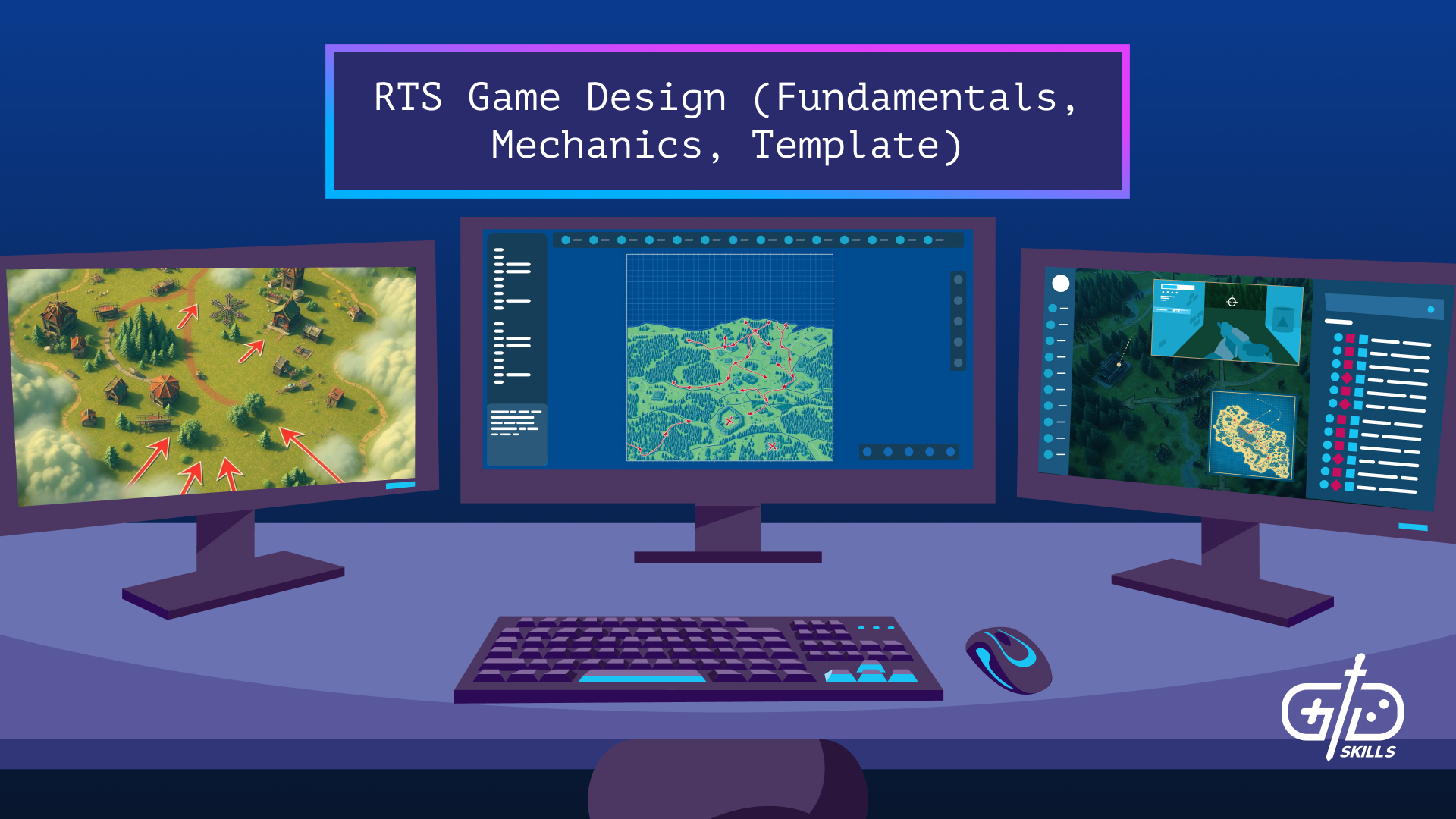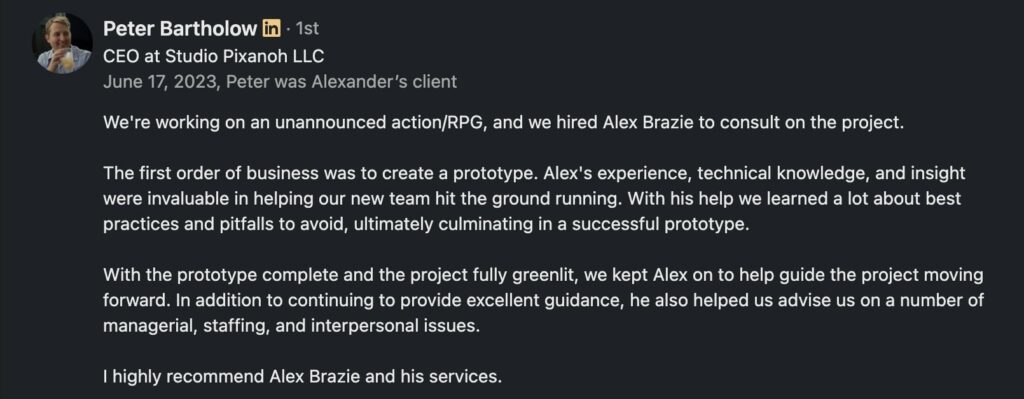RTS game design is the art of creating controlled chaos for the player. Players take on the problems of managing an army while coming up with the best strategy to defeat the enemy. The player switches between tasks quickly to defeat their opponent: building their economy, controlling their units, and constructing defenses. RTS isn’t as popular as it has been in the past, but the genre retains a devoted hardcore fanbase. Learn here about the principles of RTS games, level design, UI, and mechanics. Walk away with templates and game design document templates for getting started.
I started to become aware of games and game design around the same time that I was playing Starcraft: Brood War. As a result, RTS games and their structures are deeply embedded into my game design philosophy. Fewer high quality games were around in that era and players were far more willing to invest time up front to enjoy a title. As a result, the multiple layers of complexity in an RTS were less intimidating and the singleplayer content gave players ample time to learn the controls before the gristmill of PvP play.
The passing of time only made the genre more intimidating. The surge of pro gamers in Korea transformed the game into a focus on lightning-fast micro that’s out of reach for the average player. DOTA and League of Legends reigned in that complexity, taking away base management in exchange for a greater focus on moment to moment gameplay and agency. The shift paved the way for the RTS-like space to reach >100 million players, but, unfortunately, many of the RTS core concepts have fallen out of familiarity. Here are a few of them.
What are the fundamentals of RTS game design?
The fundamentals of RTS game design are presenting the player with important but competing tasks. The player has several units and timers to manage while they come up with an effective strategy against their opponent. Players must master switching between tasks to win, from building up the economy to researching new technologies to deploying troops to building up defenses. A major challenge to building an effective RTS is designing for multiplayer, which involves consistent support and careful balancing.
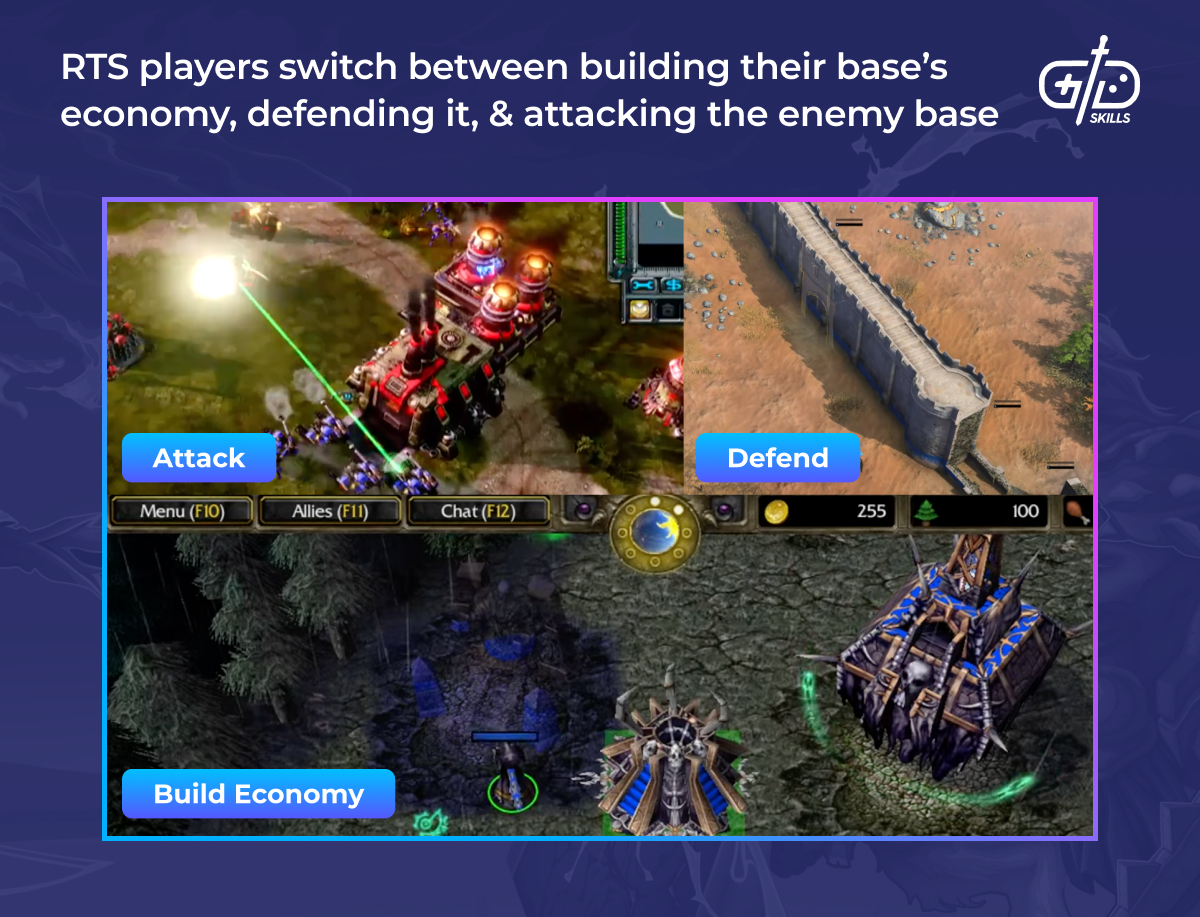
The three core actions of an RTS are building an building the economy, attacking, and defending. Each action costs time constructing buildings, training units, and moving armies, so enacting a strategy isn’t instant. The player thinks ahead to what the enemy will do in the future and creates a counter to it in the present. A successful player’s able to keep their workers busy with new constructions at all times while keeping an eye on their enemy and units in the field.
RTS is often confused with the grand strategy genre, but the fundamental DNA is different. RTS games are focused on managing a base or small group of bases to build units in a real-time battle. A significant component of grand strategy games, on the other hand, involves managing a whole nation, including managing infrastructure, diplomacy, and administrative tasks indirectly related to combat.
The Civilizations franchise and Stellaris are examples of grand strategy. Both games put players in charge of a nation that’s navigating relationships with multiple foreign nations and managing the welfare of their people. Total War is a grand strategy series that resembles an RTS with its real-time combat, but the game has a few key differences. The game’s real-time combat doesn’t include base and resource management, which makes Total War a real-time tactics game, not an RTS. The turn-based nation management is another addition lacking in a pure RTS experience.
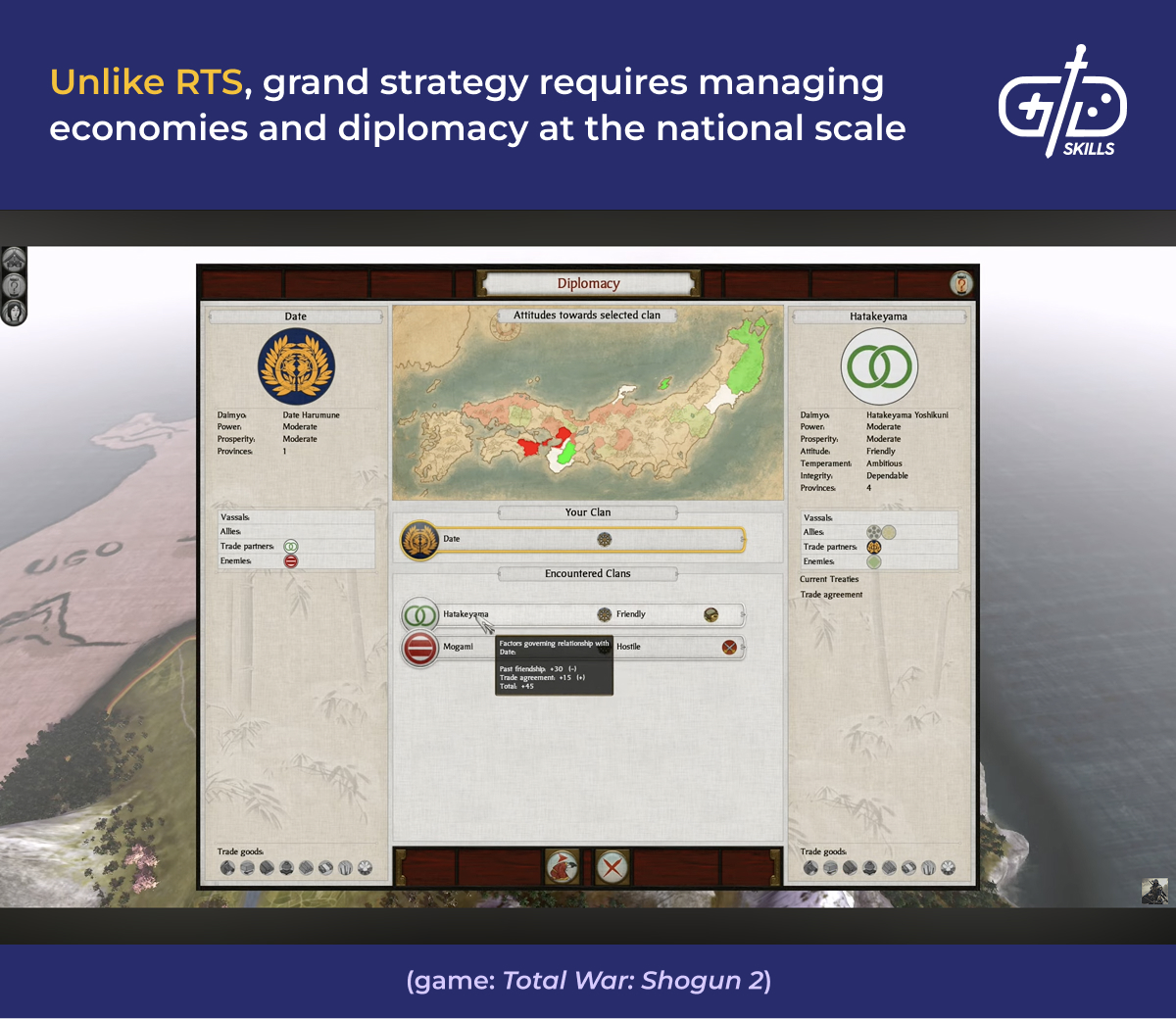
The RTS is difficult to define simply as combat with resource management, though. Offworld Trading Company is an RTS marketed on the fact it has no combat.Offworld puts players in the shoes of a mining company taking to the stars to mine and trade resources. Players have no combat units, no battle scenarios, and no combat production buildings to worry about. The goal instead is to acquire and trade resources, succeed in the market, and buy out opponents. The core of an RTS is thinking one step ahead and managing a lot of spinning plates to make that strategy happen.
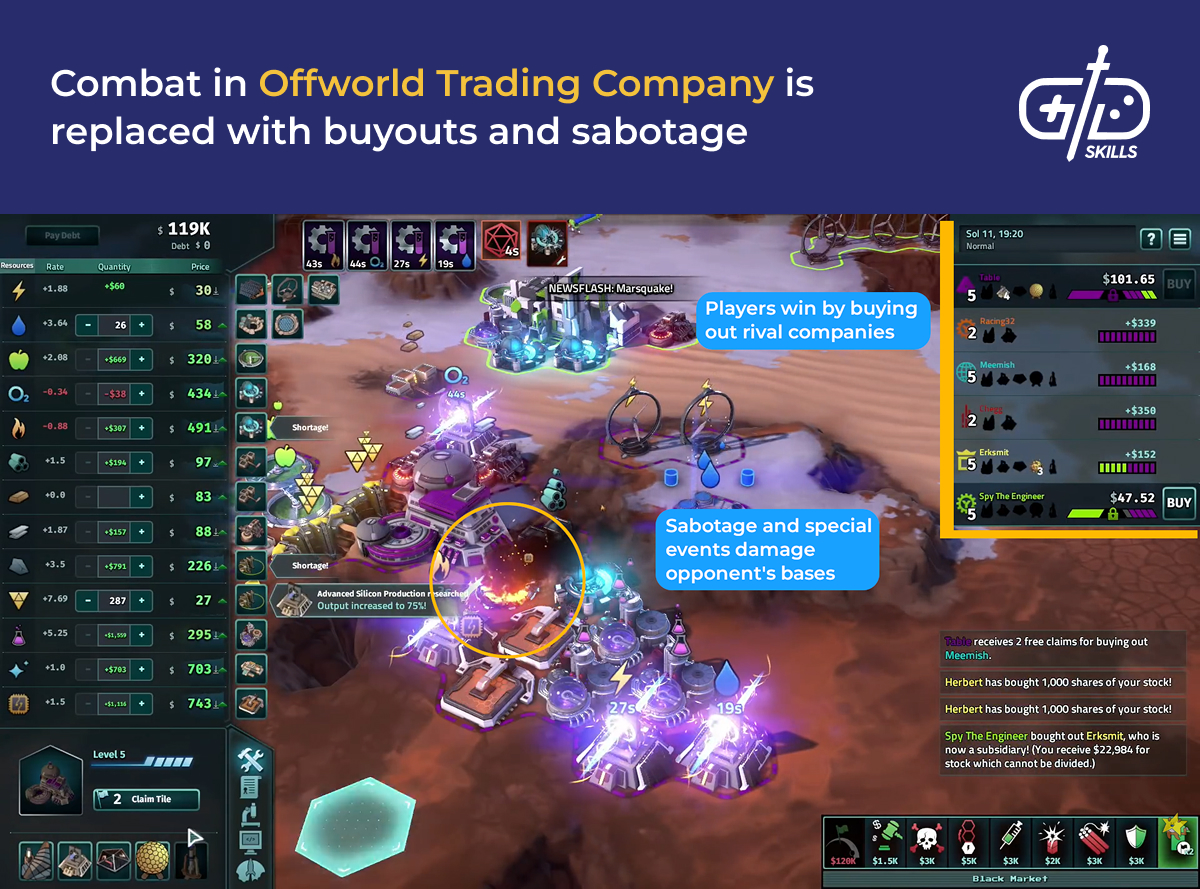
Resources and base building set the pacing of the match. They first divide the player’s attention. The resources cap how fast they’re able to build an army, so a more effective player is able to build up resources while fielding their army. The resources also help build in a natural pacing to a match. New research opens up higher quality units which give players a new edge.
The interplay between combat units and the resource economy is an essential aspect of RTS, Offworld Trading Company notwithstanding. A variety of potential units to invest in makes the decision to invest in the economy meaningful. Each opponent’s decision has an appropriate response, and that response requires a certain combination of units, defenses, and technologies. Players in Age of Empires respond to an aggressive army by building a variety of cavalry, ranged units, and infantry in response. The enemy doesn’t have to choose an open engagement, though. They have the option to build strong defenses and hide. The player has their own response to this strategy: to invest heavily in technology and bust their defenses with siege engines.
WarCraft 3 places strict caps on resources to guarantee a less peaky experience. The number of units in play reduces gold income by a percentage, meaning the army sizes are smaller and each lost unit is a major loss. The smaller army sizes in WarCraft 3 encourage using every resource to get ahead. Building up an economy at home is a start, but players who effectively loot NPC camps in the center of the map build up their economy faster and are better prepared to fight earlier, an important edge.
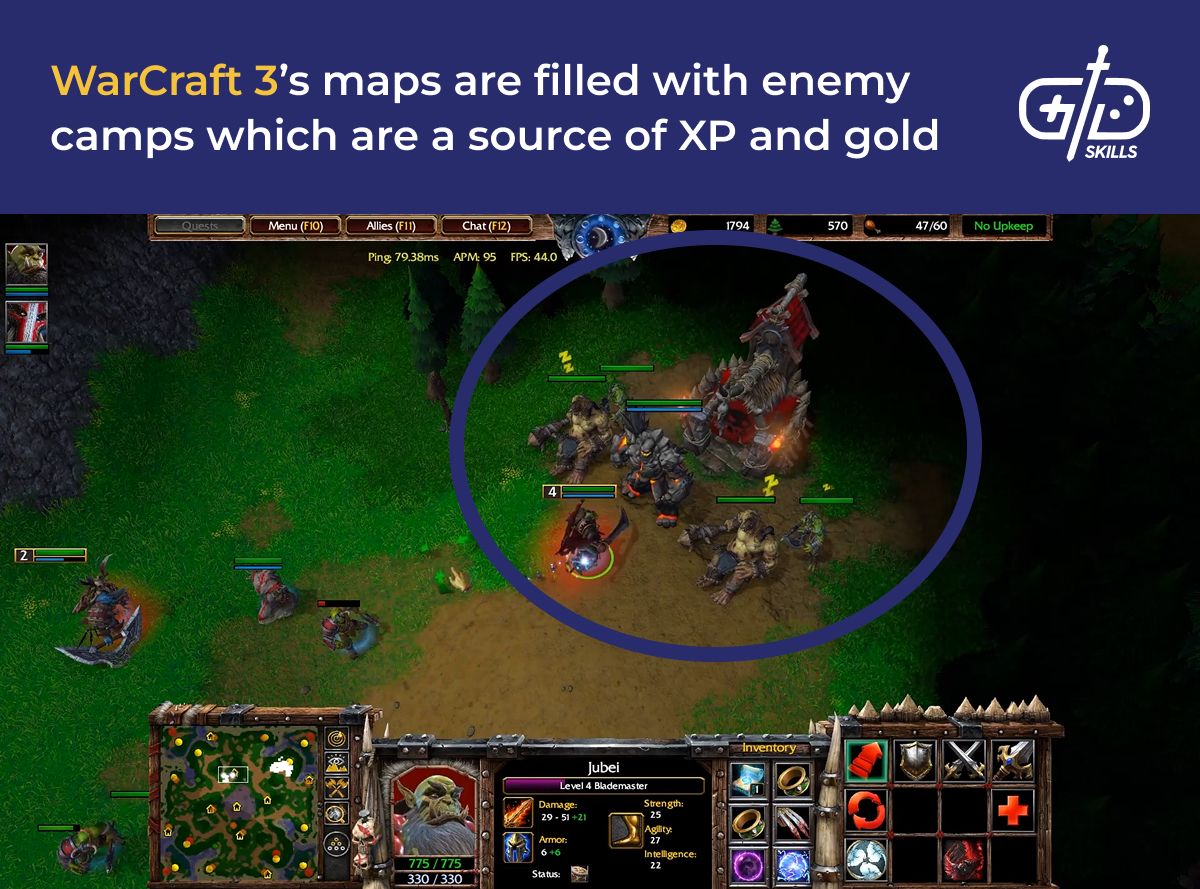
Resources, workers, buildings, and military units are the core pieces of an RTS, and they’re a lot to manage for new players. A major goal of singleplayer campaigns is to introduce players to the technologies available to them, get them used to different objectives and strategies, and prepare them to engage in multiplayer. Memorable campaigns include StarCraft 2’s creative gameplay scenarios, Age of Empires’ historical battles, and Command & Conquer’s campy storylines.
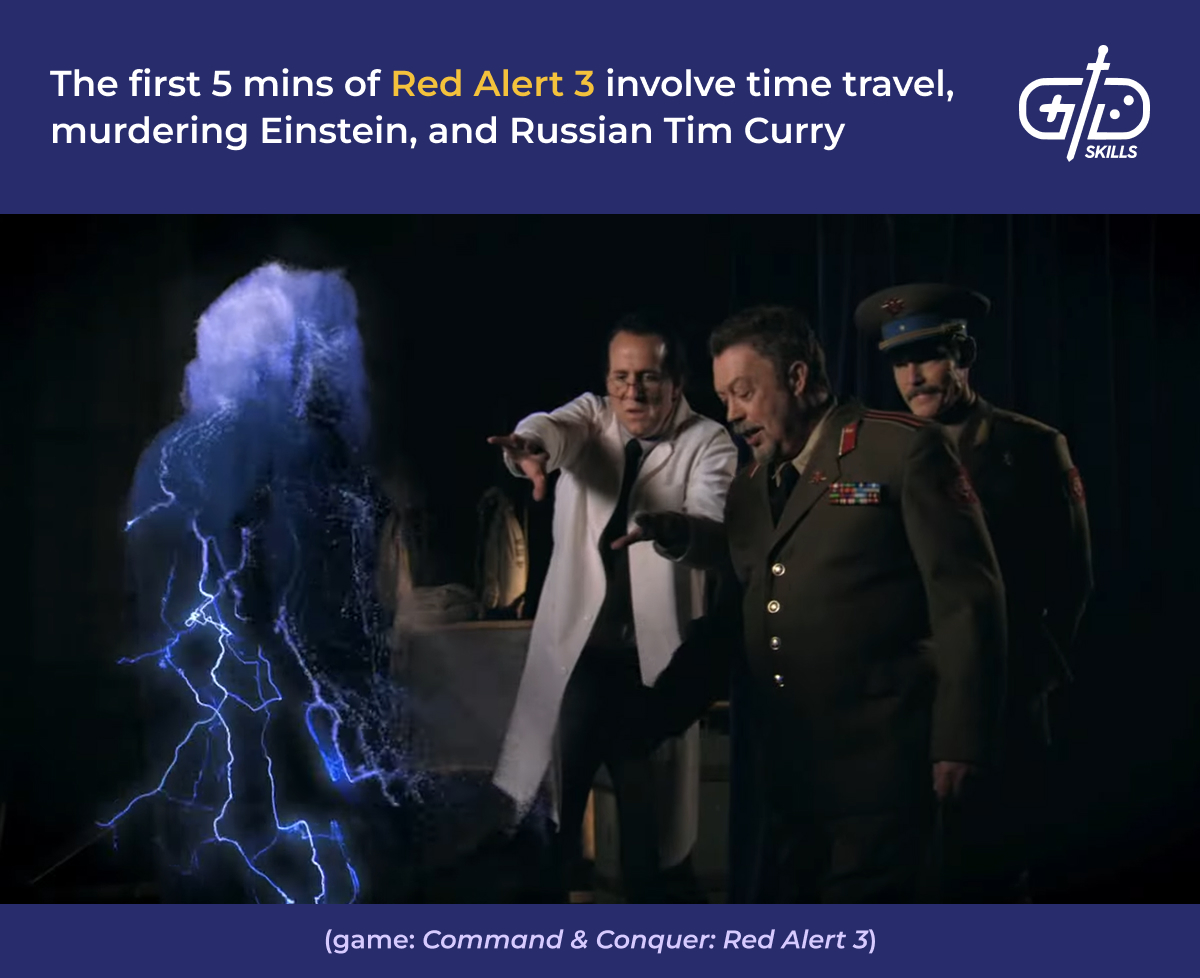
Robust enemy AI in RTS games is essential not just for singleplayer campaigns but multiplayer too. Co-op multiplayer has a much lower barrier to entry when played against bots. Having fun with friends over an RTS in a low pressure setting helps work on the multitasking skills required to succeed at PvP in the future. AI opponents also help keep multiplayer matches going when the player pool is low. Offworld Trading Company doesn’t even let the player know which players are humans or bots in a mixed match.
Enemy AI has several layers to deal with the different facets of gameplay. The AI has the same overall goal as the player: to break the player’s economy by destroying their base. The AI as a result has a number of handlers for different mechanics. One handler paths between locations, while another controls units in combat. One builds the components of a base, and another researches technologies. Several pieces work together to reach a combination of resources and units that presents the player with a real challenge.
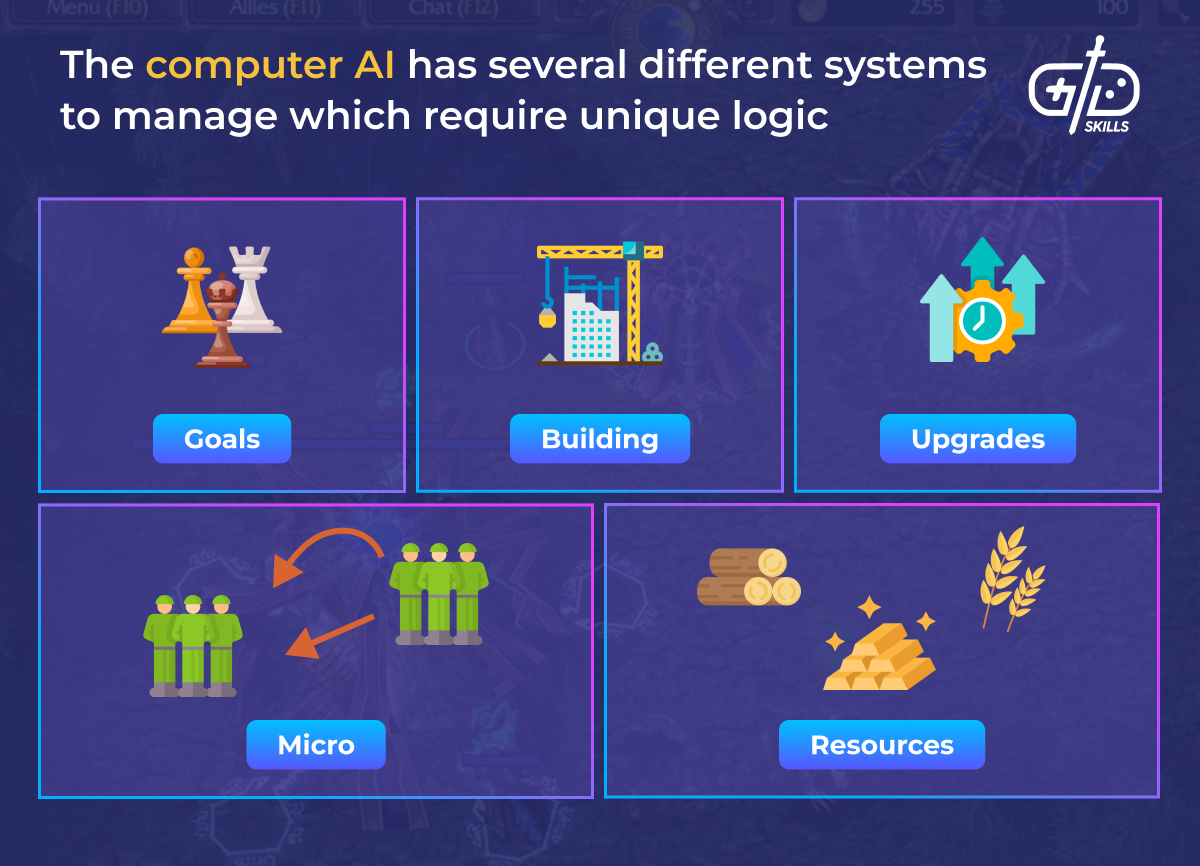
RTS games place a big emphasis on competitive multiplayer. An engaged competitive community keeps games alive for years, even decades in the case of StarCraft: Brood War. The challenge is supporting the community over time, which is a decision the studio must make in advance. Dustin Browder says esports was the driving factor behind the design of StarCraft II. The community has continued to see support and updates to this very day due to Blizzard’s resources and dedication to the community.
Not every company is Blizzard. Ongoing support is a challenge. The technology behind the servers and web services eventually becomes obsolete, licenses expire, and unforeseen issues occur from time to time. Offworld Trading Company’s multiplayer is a large part of its appeal, and as of the time of writing has run into technical trouble. Unity’s service UNET has become obsolete, and the retirement of the service requires the devs to find a solution for the nearly 10 year old game to continue its life.
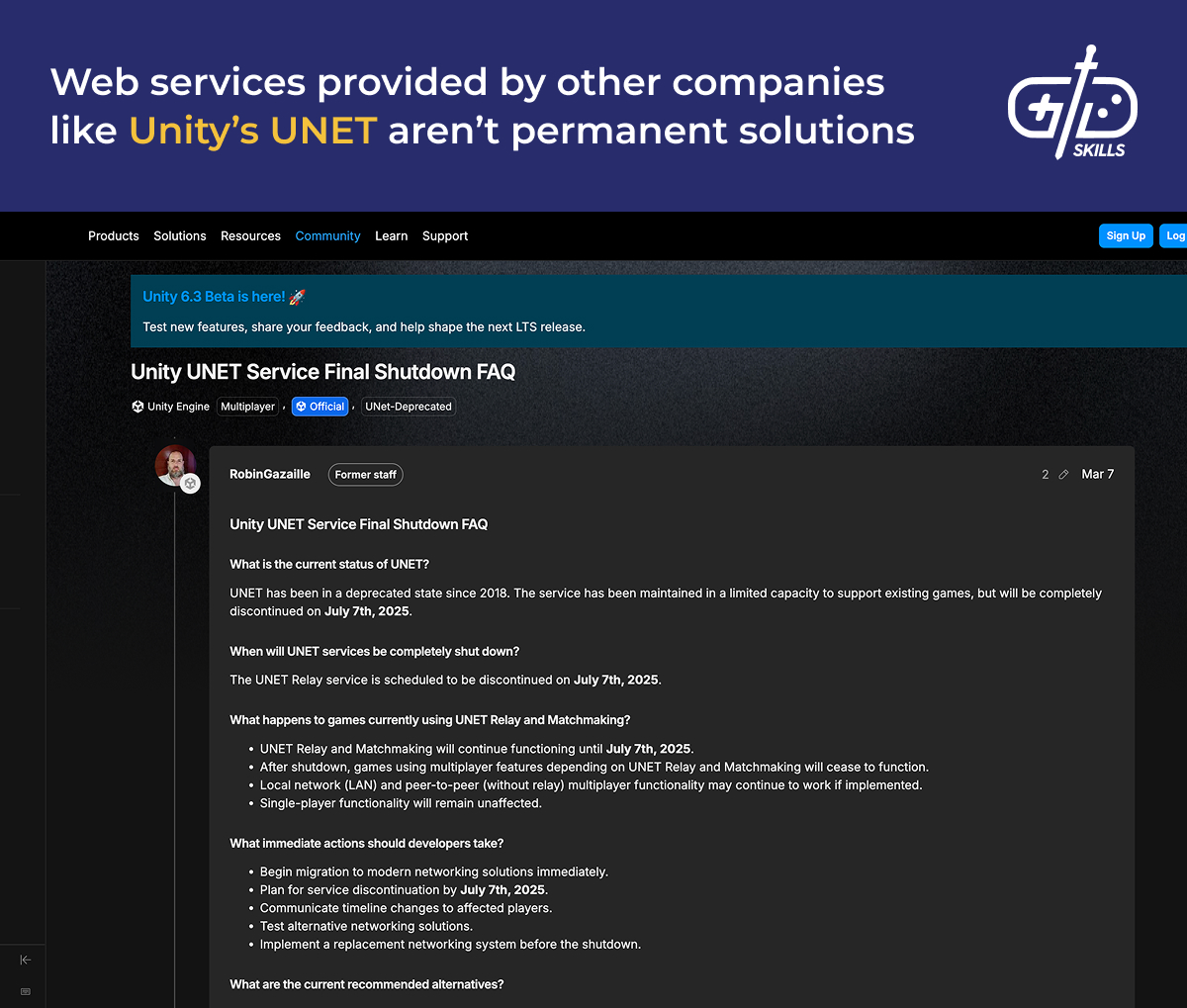
Balancing tweaks are important for an active multiplayer experience. An unbalanced RTS, and even a balanced one, runs the risk of two scenarios. The first is that a large number of games get decided early on, with the first player to fall behind assured they’ll never be able to come back. Another scenario is a slippery slope situation, where winning more battles and getting a better economy puts the player in an increasingly safe position so that the route to victory becomes easier with each success, creating the same problem. Changing up the effectiveness of units changes up the meta and makes sure the game stays fresh; read on below to learn more about balancing units.
Multiplayer matches in an RTS tend to be on the shorter side. An hours long match fits the idea of a back and forth battle, but doesn’t fit the quick decision making of an RTS. Average matches tend to last less than half an hour, so consider balancing around this value. There isn’t a set maximum, though. Sins of a Solar Empire combines RTS gameplay with 4X empire-building elements, and matches often take an hour at minimum.
RTS creators often have the competitive scene in mind when they design an RTS. Online multiplayer was brand new at the time Dune II introduced the world to the RTS, so there wasn’t an option for competitive play at the time. WarCraft: Orcs & Humans shipped with online multiplayer, as basic as it was for the time. StarCraft: Brood War became a popular title in South Korea due to its strategic gameplay. New strategies and counters to those strategies emerged for years after the last balancing patch. StarCraft 2 continued the focus on competitive play with a relatively small number of well-balanced units, and it still sees attention in global esports competitions today.
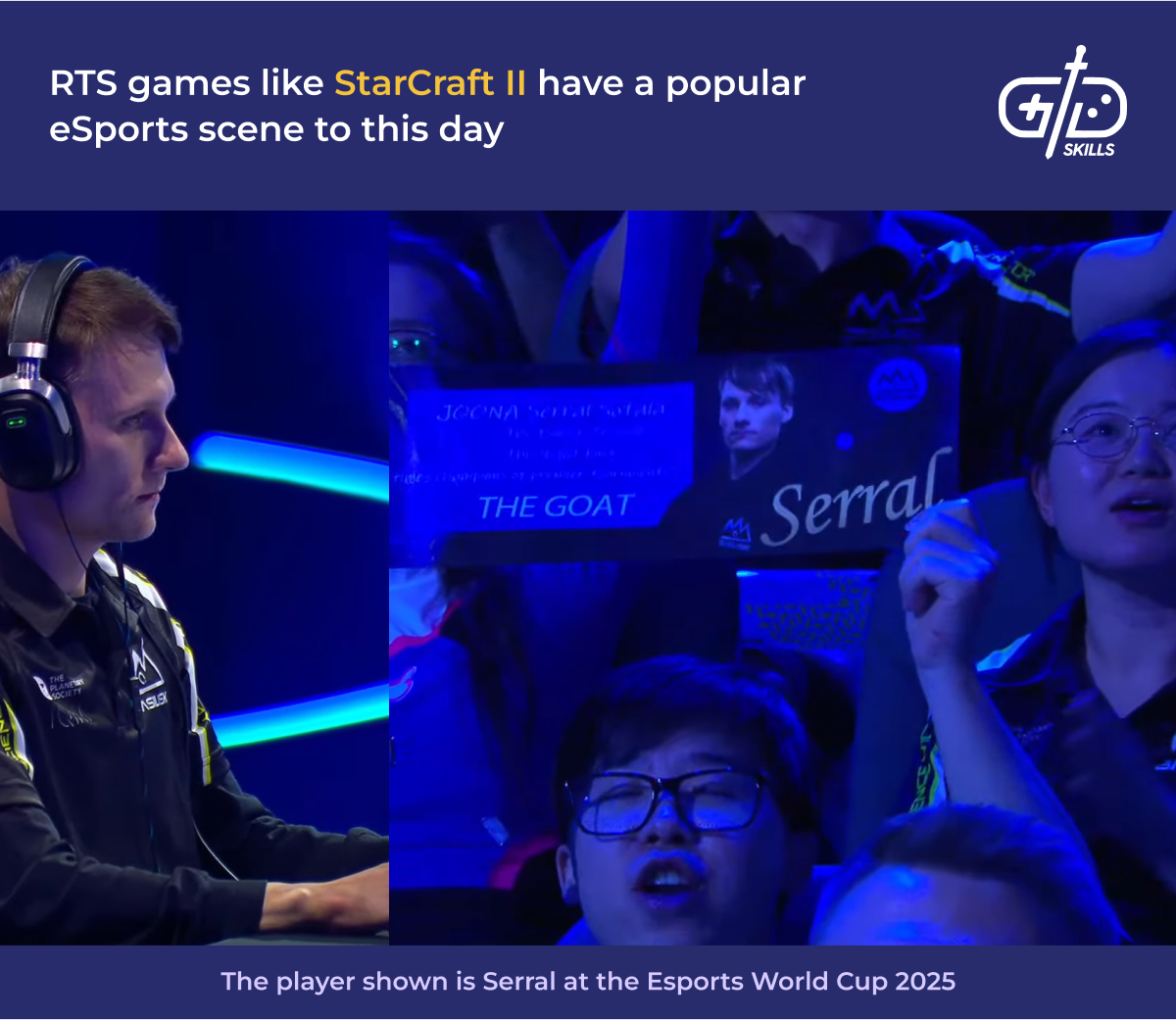
How to design levels for a RTS game?
Design levels for an RTS game by considering how to encourage combat. Some players hide in their base, so a level with a variety of strategic objectives balances the risks of venturing into the unknown with meaningful rewards. Multiplayer missions aim for a fair and balanced experience on each side. Campaign missions, on the other hand, follow different principles. There is a lot more room for creative situations and limitations in singleplayer where the experience is curated from beginning to end.
Differences in terrain and elevation add an extra dimension to unit management. The terrain determines the paths units are able to take, choke points, and the best avenues of assault against the enemy base(s). Hills and forest act as cover for an army to escape into, as hilly and winding terrain restricts unit sightlines. Ranged units are less effective in a dense and varied terrain compared to open fields.
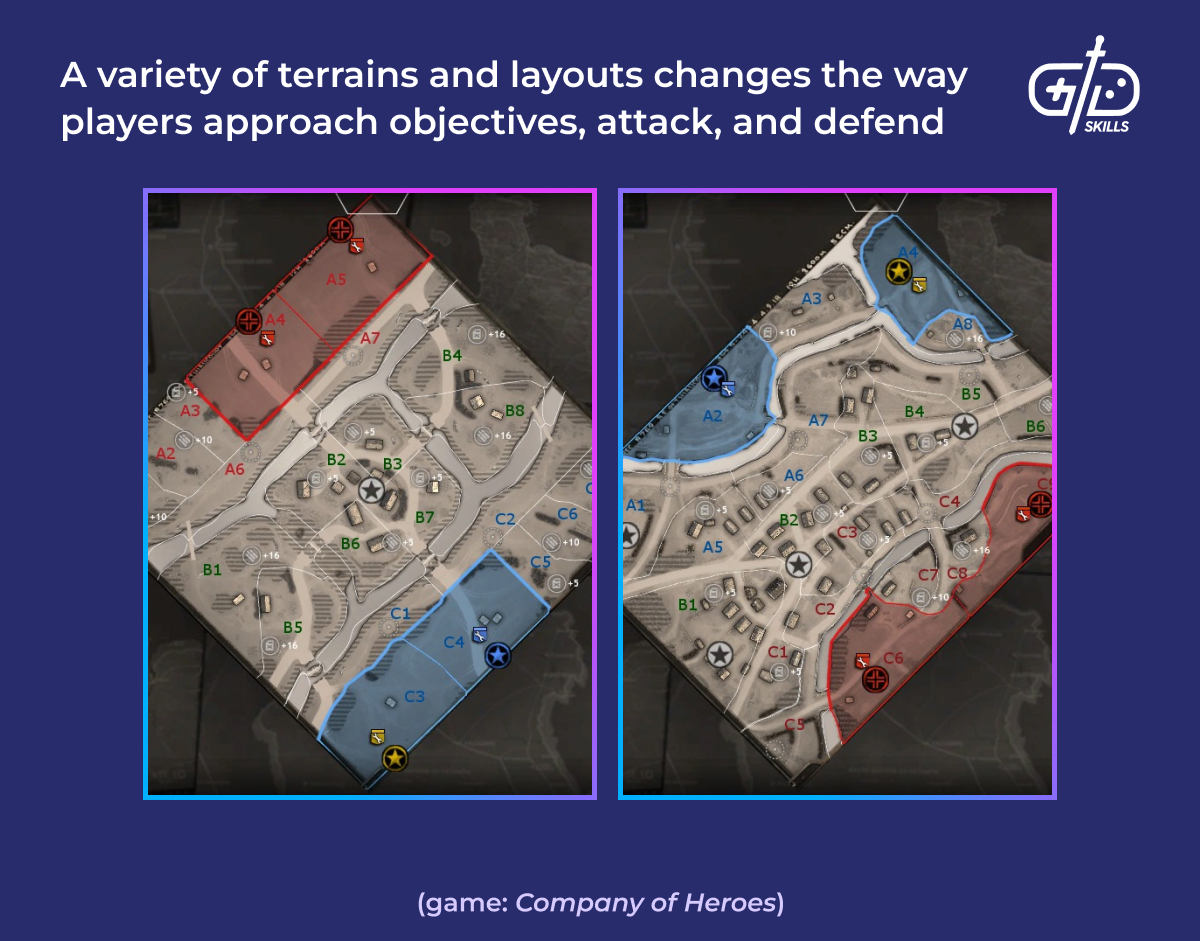
The strategy aspect of an RTS comes from predicting what the enemy will do next and preparing a response. Fog of war prevents players from having a completely omniscient view of the map. Unexplored areas are completely invisible to the player’s camera, including on the minimap. Explored areas are visible, but enemy movements, bases, and most other events are invisible when an allied base or unit isn’t in the area. Gathering information about the enemy becomes a challenge to overcome with in-game tools: scouts, base modules, and combat units.
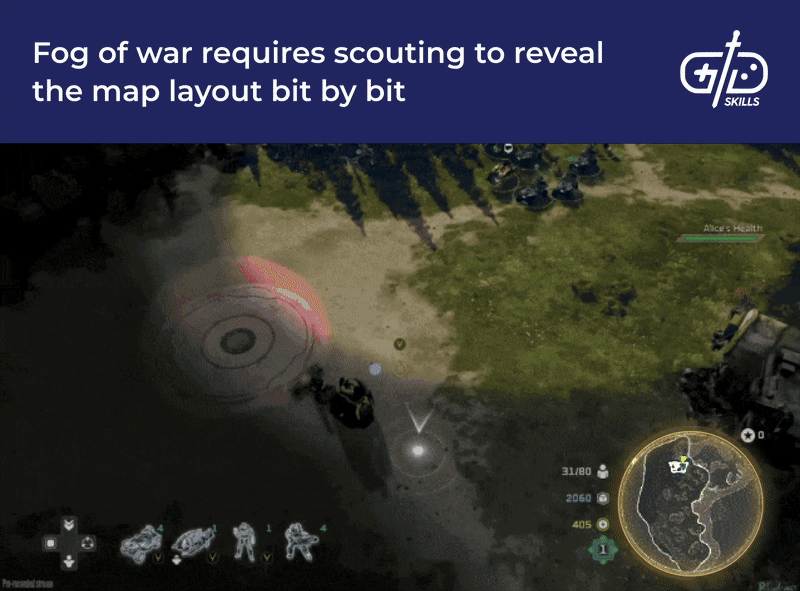
Another important feature of level design in an RTS is choke points. Choke points add another tool in the player’s box for responding to the enemy. A smaller army standing in a chokepoint isn’t going to get surrounded and has a much better chance at holding back a larger army there, which makes placement an important part of strategizing. Melee Protoss Zealots are a more powerful unit than the ranged Terran Marines, but in a chokepoint, the marines’ range makes them more effective.
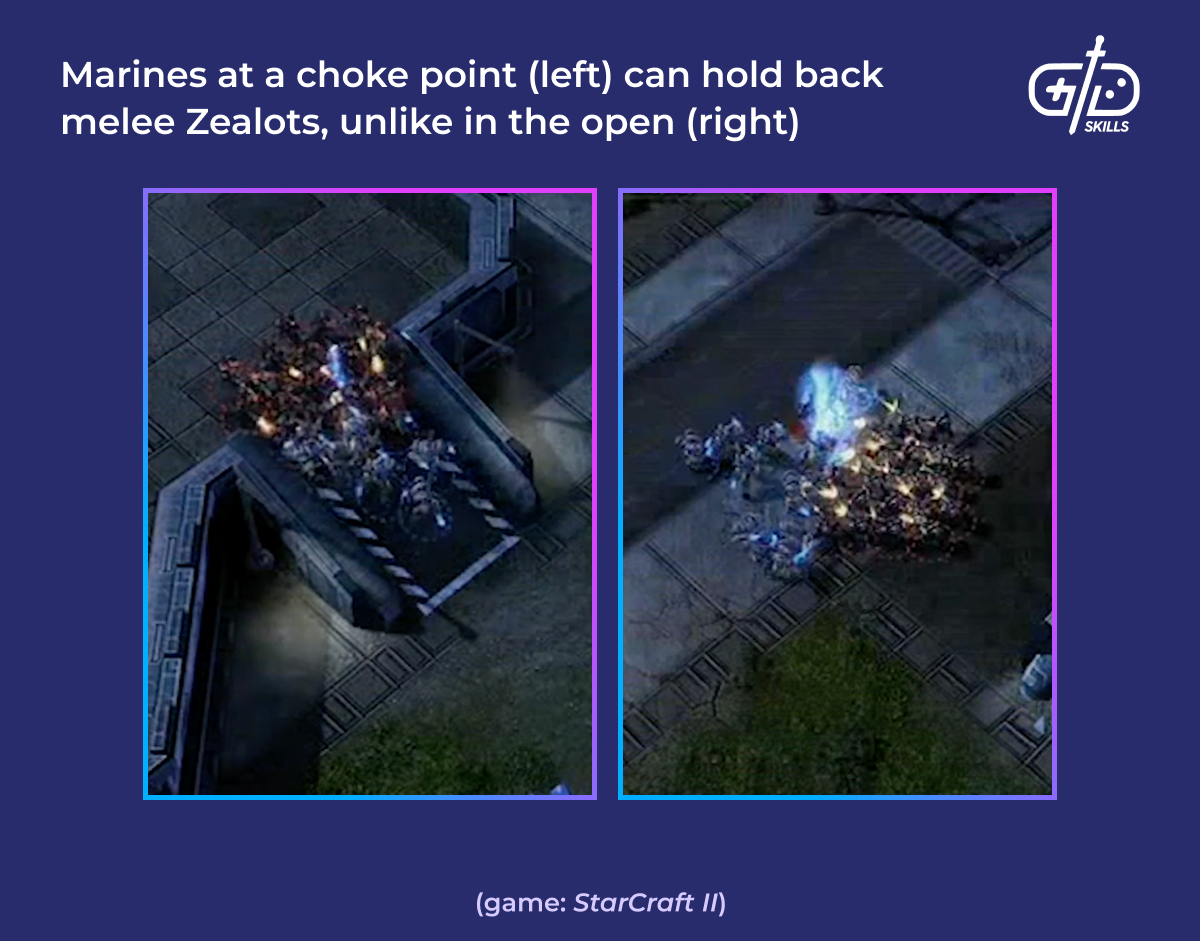
Placing resources in the no man’s land between bases encourages players to venture out into conflict. Creating farms, for example, generates stable food in Age of Empires, but foraging is another source of extra early game resources. Sometimes the better strategy is to forage and save for later in the game. Some resources such as wood, stone, ore aren’t renewable and there’s no option but to venture forth from the base to gain enough building materials for an advantage.
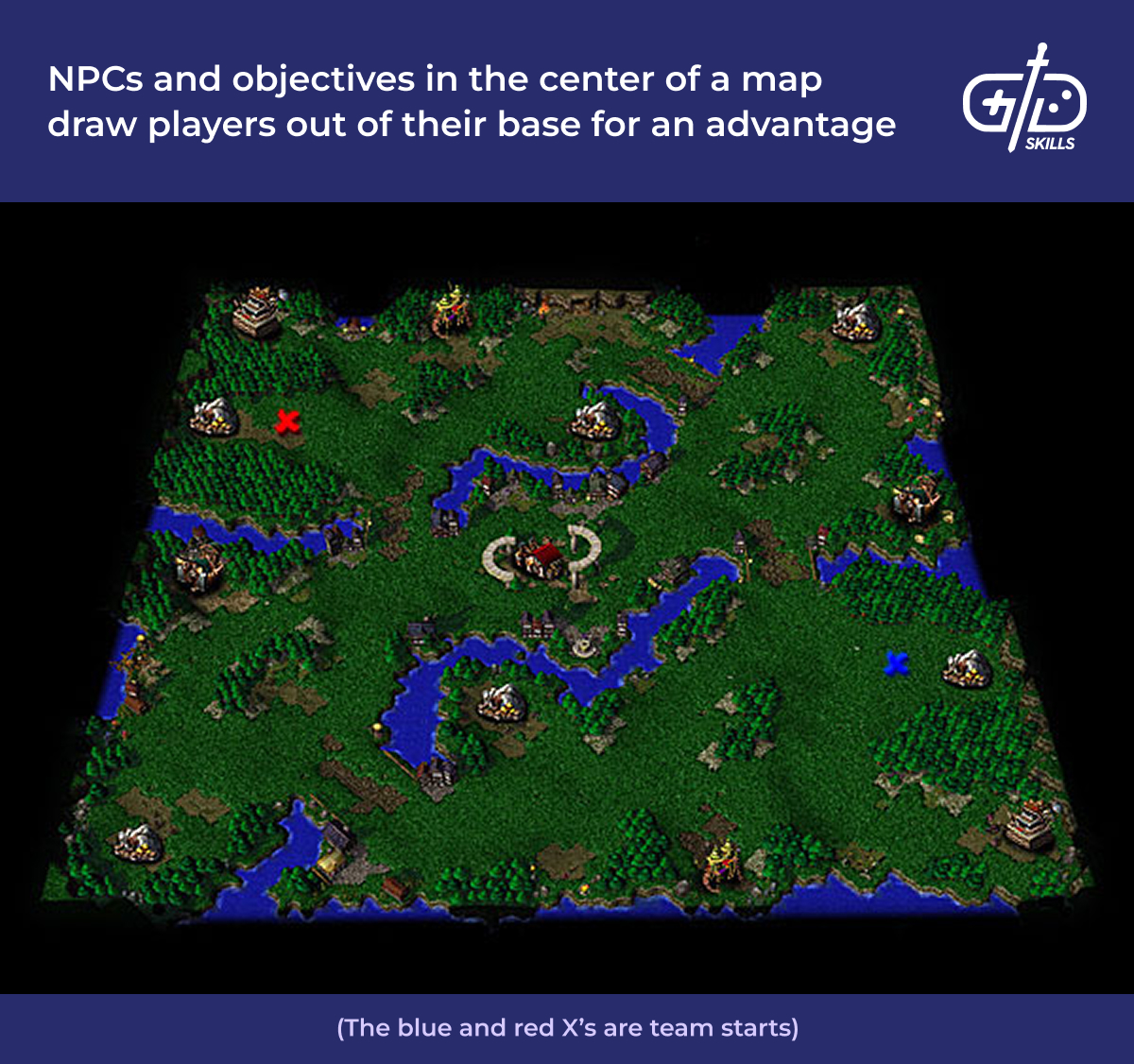
Resource management is important to consider for setting the match pacing. A limited availability of resources keeps the match from ending too quickly. Mobbing the enemy before they’re able to build up their resources is a viable playstyle in RTS games such as StarCraft (and not a very fun one for the loser). Adjusting the rarity of resources and their proximity to bases changes how quickly players are able to build their economy.
Having a variety of objectives to choose from makes matches more dynamic. A player that ventures into the middle of the map for ore deposits or food runs the risk of battling the other player for those resources. Leaving the objectives alone, though, means the opponent is free to get them first. The way objectives affect the game changes from match to match as a result: sometimes two players decide to go after an objective and battle for it, at other times they get ignored. Sacred Sites in Age of Empires, for example, offer victory when a team captures them all, but that team has to hold them from the enemy for a certain amount of time.
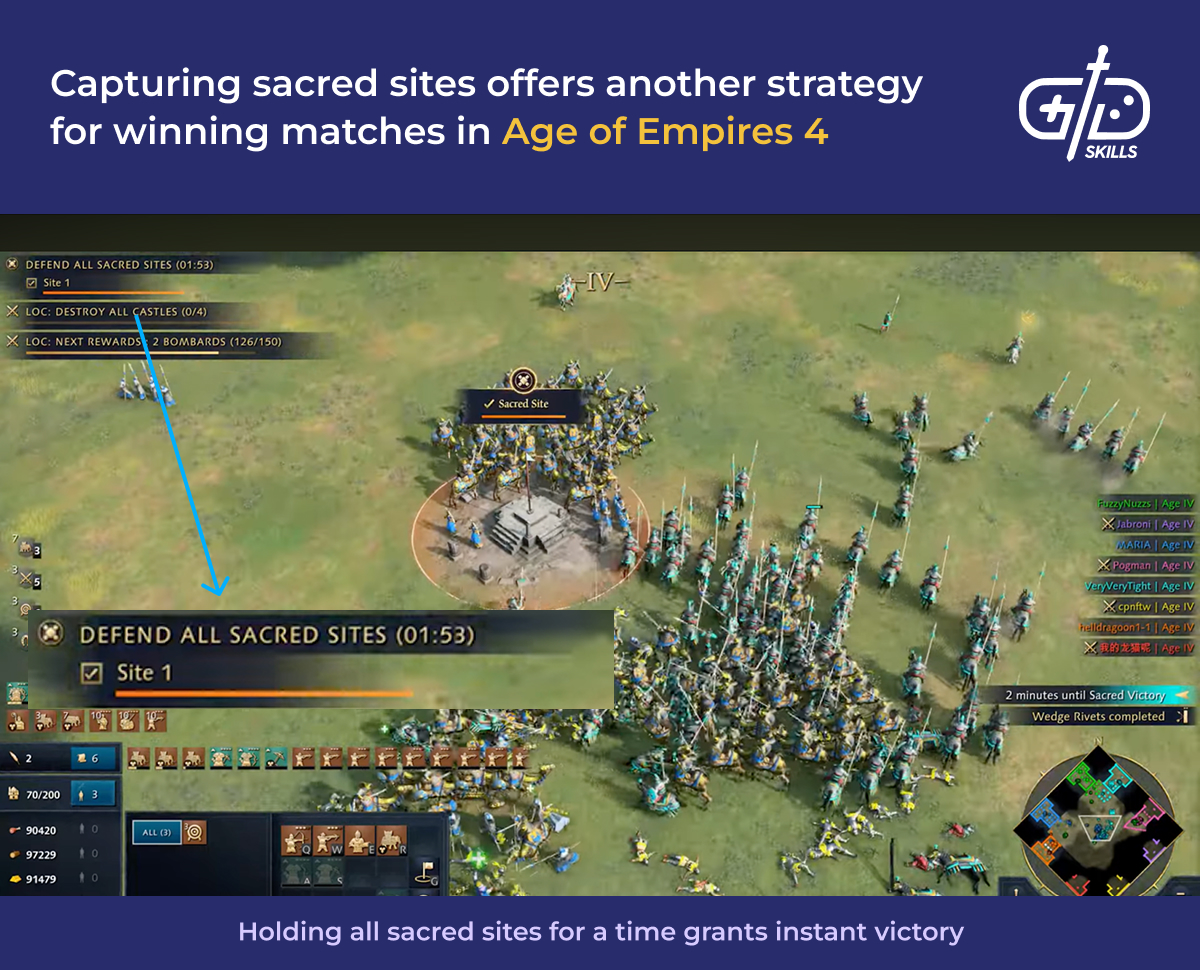
Missions and singleplayer maps offer a lot of room to curate the experience compared to multiplayer. Novel mechanics, story moments, and interesting environments keep up the pacing in an RTS mission. Dustin Browder of Blizzard says there’s a 3 act structure they aim for: a low intensity intro (usually a story briefing), then an unforeseen wrinkle or complication, and a final big battle before mopping up the enemies.
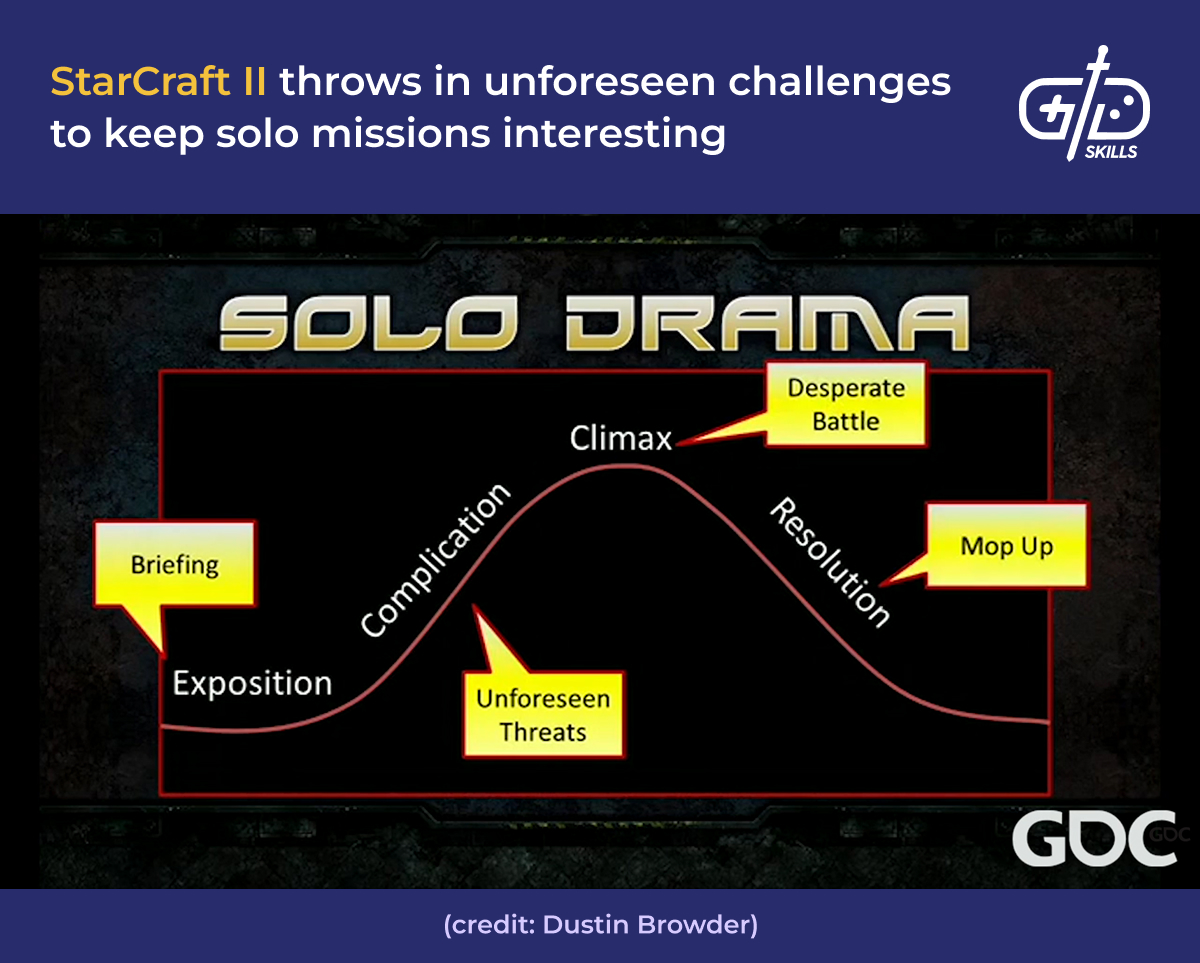
The campaign missions of StarCraft II use the story setup to create the target 3 act structure. Outbreak is a mission where the player must cleanse a Zerg infestation. Infected Terran enemies hide during the daytime, giving the player the chance to rest, recover, and take out nests, but they attack in great numbers at night, making it critical to use the daytime wisely. The game gets increasingly tense as the numbers of terran infected build up, but then relaxes again as they finish mopping up the infected nests.
Other missions in StarCraft II use the environment to play with the player’s attention. The Devil’s Playground puts players on a lava-covered planet where the low ground, full of valuable minerals, frequently floods with superheated rock. The goal is to mine enough minerals to finish the mission, so the player must frequently head in and out of the low ground to accomplish the objective.
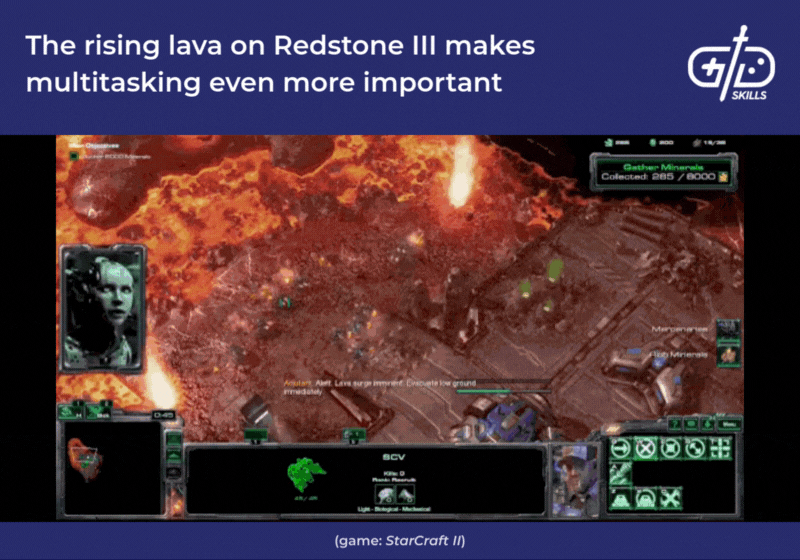
Great RTS maps, then, apply a mixture of the core gameplay (basebuilding, unit micro, etc.) with a novel, memorable adaptation that pushes the limits of the player’s toolset. There’s no need to grow and adapt If the player doesn’t lose or at least feel the pressure of losing. Acquiring new tools and facing levels where applying a new tool to manage the level’s pressure is one of the best ways to teach players complex game features.
Cloaking in StarCraft is an example of building pressure to teach players a mechanic. Cloaking is first introduced as a serious threat. Players only have access to stationary detection towers for dealing with cloaked enemies. The player must place towers strategically and stay close to them to defeat the enemy. The game introduces the mechanic in this more difficult context before introducing detector units and other methods for dealing with cloaking later.
An interesting change to the terrain also makes for unique missions. Homeworld’s approach to maps is radically different even from other space RTS games because of its full 3D movement. Homeworld’s battles take place between armies composed of capital ships and their fleets. Each ship is able to move up and down at the player’s whim in addition to their standard flat-plane controls. Units have different thicknesses of armor on different parts of their chassis, so players are encouraged to use the 3D movement to get a leg up on their competitors.
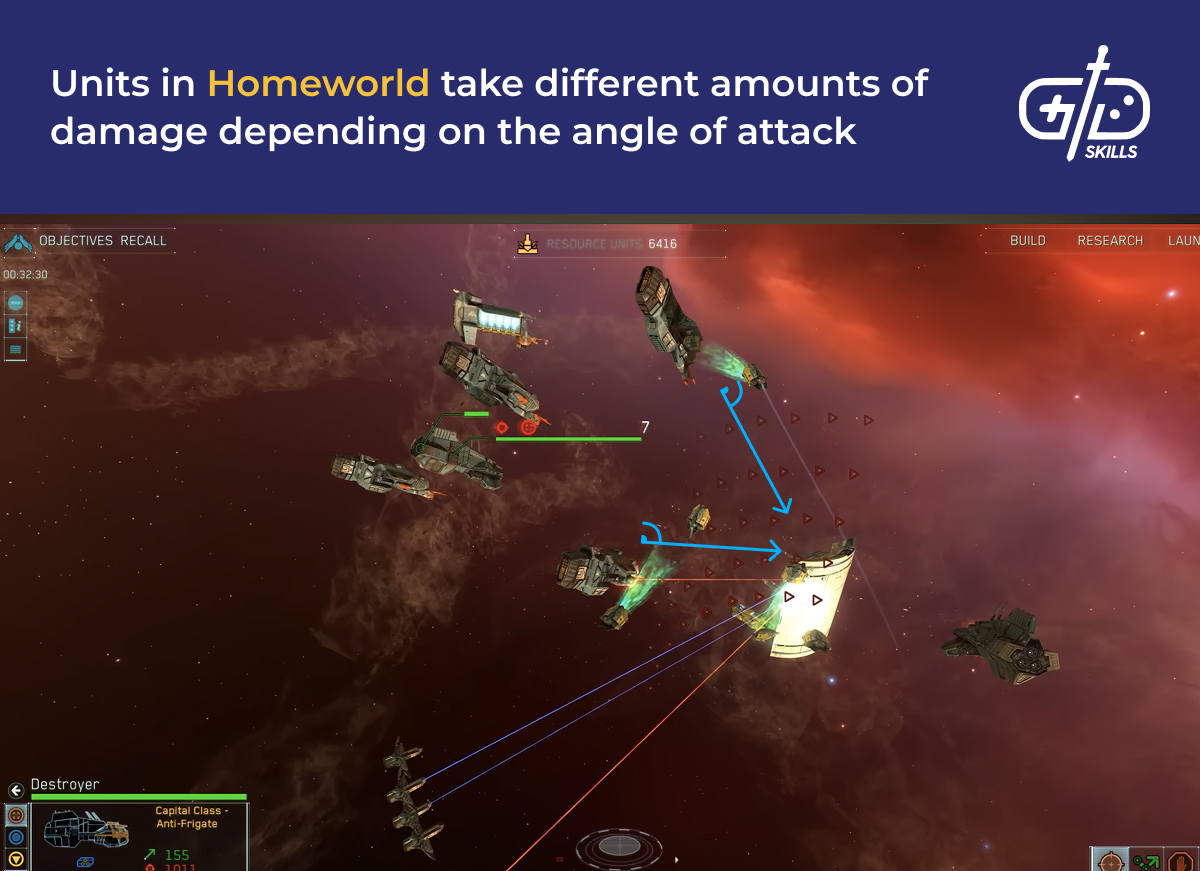
Multiplayer maps follow different principles from singleplayer. A custom games system and mod tools help keep the community alive with new maps to play around with. Maps that are the same every time allow experienced players to memorize the map and run the same optimal strategy. Random generation of the whole map or the objectives that appear on the map helps make sure the game’s existing maps challenge the player. WarCraft 3 randomizes the creeps (neutral enemy NPCs) on the map, so players must explore to learn their strength, special abilities, and strategic value.
How to design UI for an RTS game?
Design UI for an RTS game that balances efficiency with accessibility. The balance is easier said than done. UI is usually outside the domain of mechanics and systems design, but RTS games are complex and different types of UI change how players approach the game. RTS games are about multitasking, so notifications and shortcuts for complicated actions are important for managing the game.
No RTS UI is 100% ideal. The goals of a UI are minimalism and clarity, which clash with the complex gameplay of an RTS. The industry, however, has settled on a consistent set of tools for helping the player parse the state of the game. An RTS HUD contains a minimap, resources counter, command list, upgrade menu, and meters showing the status of units and buildings. There are often notifications showing when workers are idle, so the player has an idea whether they are using them as effectively as possible.
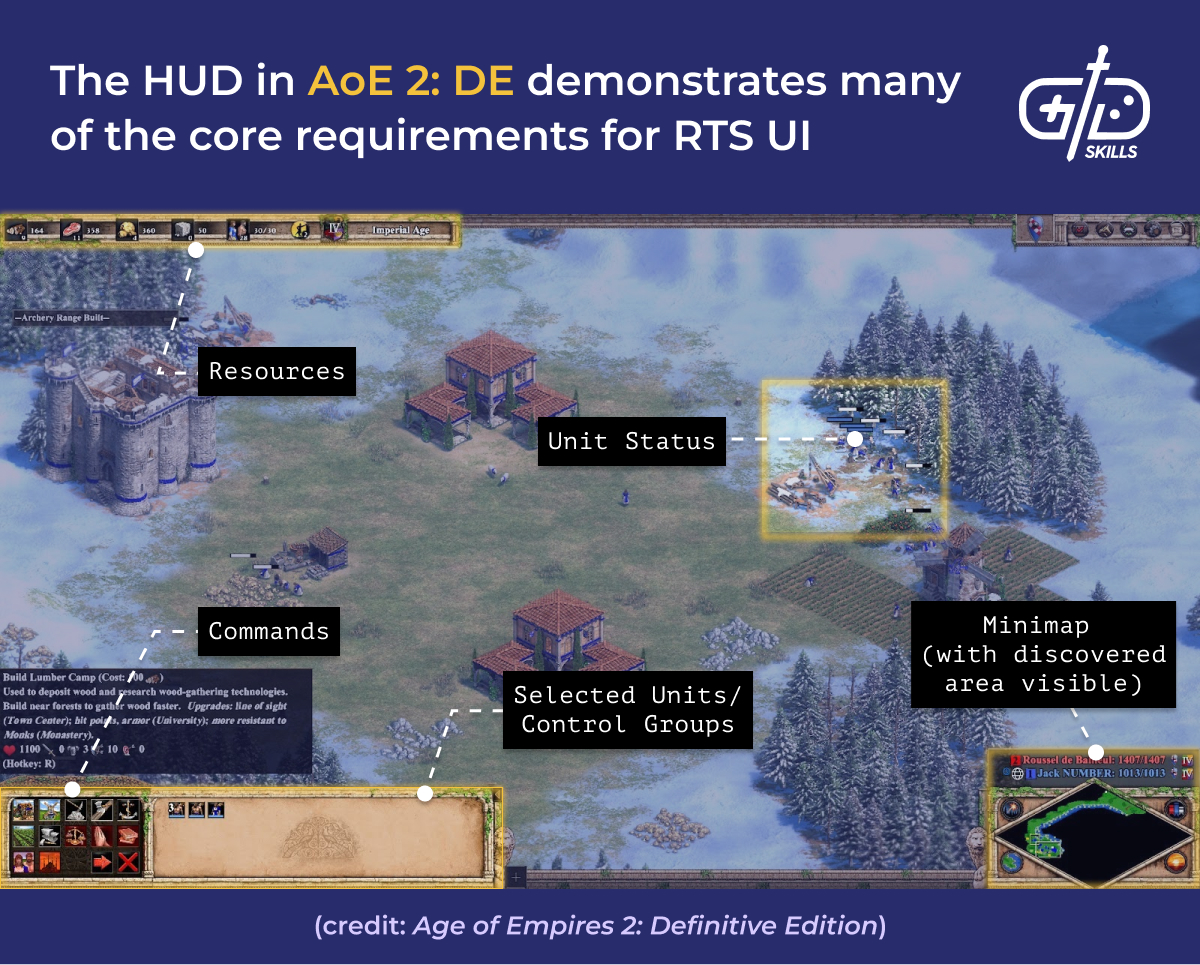
The multi-tasking in an RTS requires hotkeys and shortcuts to make the game systems manageable. Top players are able to perform two, three, four hundred actions per minute, and that kind of speed isn’t achievable by moving a mouse back and forth. The standard is to map them to the control button. Players assign units and buildings to a group by pressing control and a number. Pressing the same number later selects the same group. Hitting CTRL + 1 while selecting all the archers means hitting 1 selects the archers later, for example, for giving them quick orders.
Each game’s UI has different priorities. The Supreme Commander games and their strategic zoom removes the need for a minimap and gives the player seamless control over the battlefield. The Command and Conquer series keeps the UI as out of the way as possible, showing the clearest possible view of the battlefield at any given time.
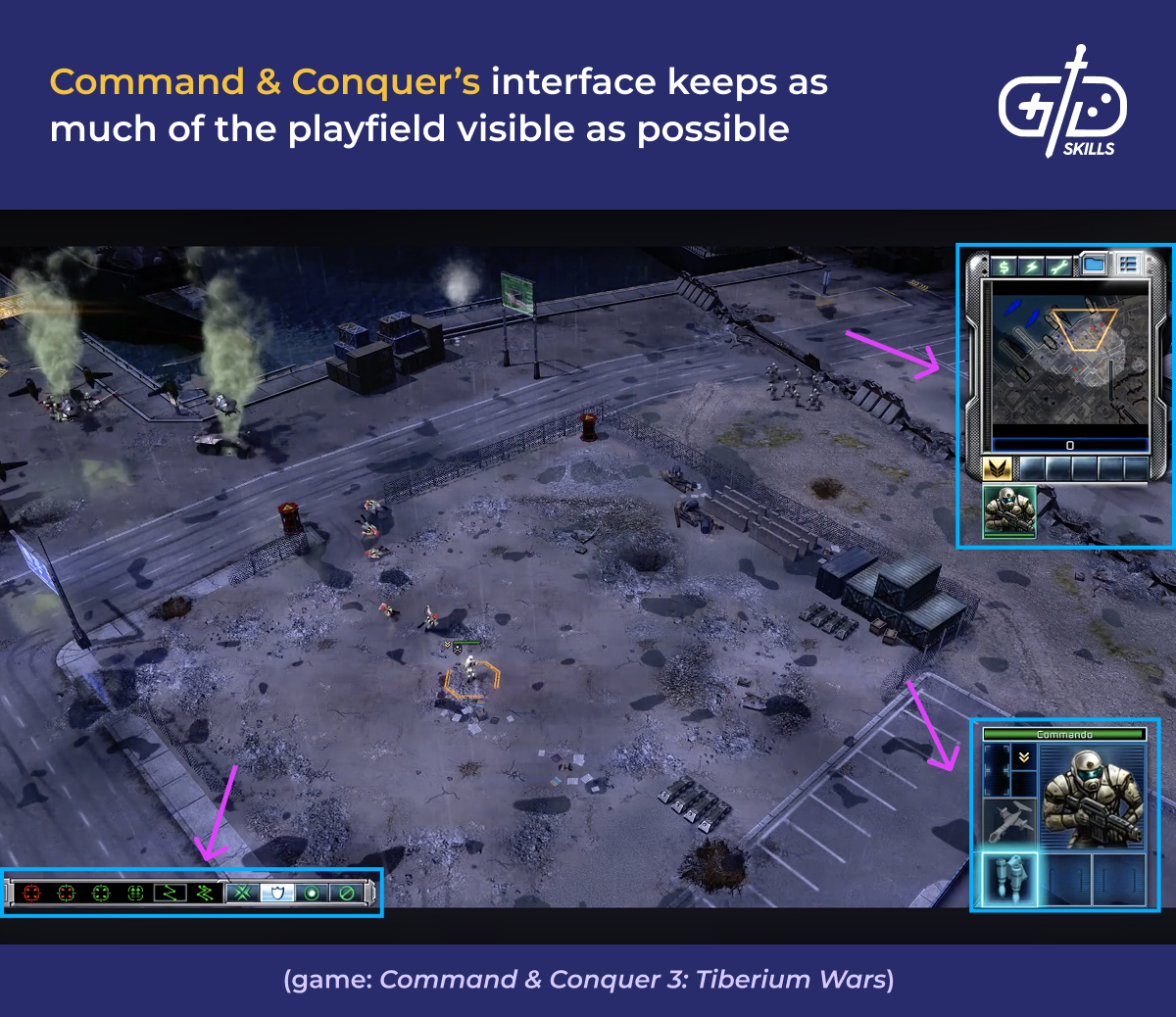
The main menu and multiplayer navigation are another crucial component to get right when PvP is such a large part of the genre’s appeal. Custom games with highly configurable options let players create their own fun with the system for years to come. RTS games are a niche genre, so they need to be prepared to deliver a configurable experience to players. Offworld Trading Company uses its UI to attract players to multiplayer, putting a message on the multiplayer button whenever a match is available.
What mechanics are used in real time strategy game design?
Strategy comes from not only switching between attacking, defending, and economy, but having choices within those categories. Differentiating units through numbers alone doesn’t make for interesting choices: not just higher damage, but special abilities, ranges, and sizes give them meaningful advantages. Building the economy is another important component of balance. The speed of growth in the economy directly affects how quickly players are able to progress.
Every video game consists of four layers of content: strategy, tactics, disruptions, and recovery. The first two are immediately relevant for the discussion here. Strategy is what the player does before an encounter. Deciding what faction to play, what build order to use, and when to attack the enemy is strategy. Tactics is what a player does in response to an enemy strategy. What makes RTS games dynamic is the number of options a player has for choosing the right response to an enemy action.
Managing units is the first approach in the player’s tactics toolset. Balancing units against each other is complex, but rock, paper, scissors (RPS) design is a common way to start balancing units. The approach is to design each unit to be weak against one unit and strong against another, just as each move in rock paper scissors has a perfect counter and perfect weakness.
Perfect countering isn’t the goal here since that removes the role of skill, terrain, and upgrades in deciding battles. There are, however, some advantages to beginning with the RPS approach. The first is that the system is easy for players and designers to wrap their head around. RTS games are complicated and difficult to balance, so having a clear goal for each unit sets a solid foundation. Easy readability for players makes it easier to respond actively during the match: a player that suspects their opponent is building cavalry builds pikemen in response.
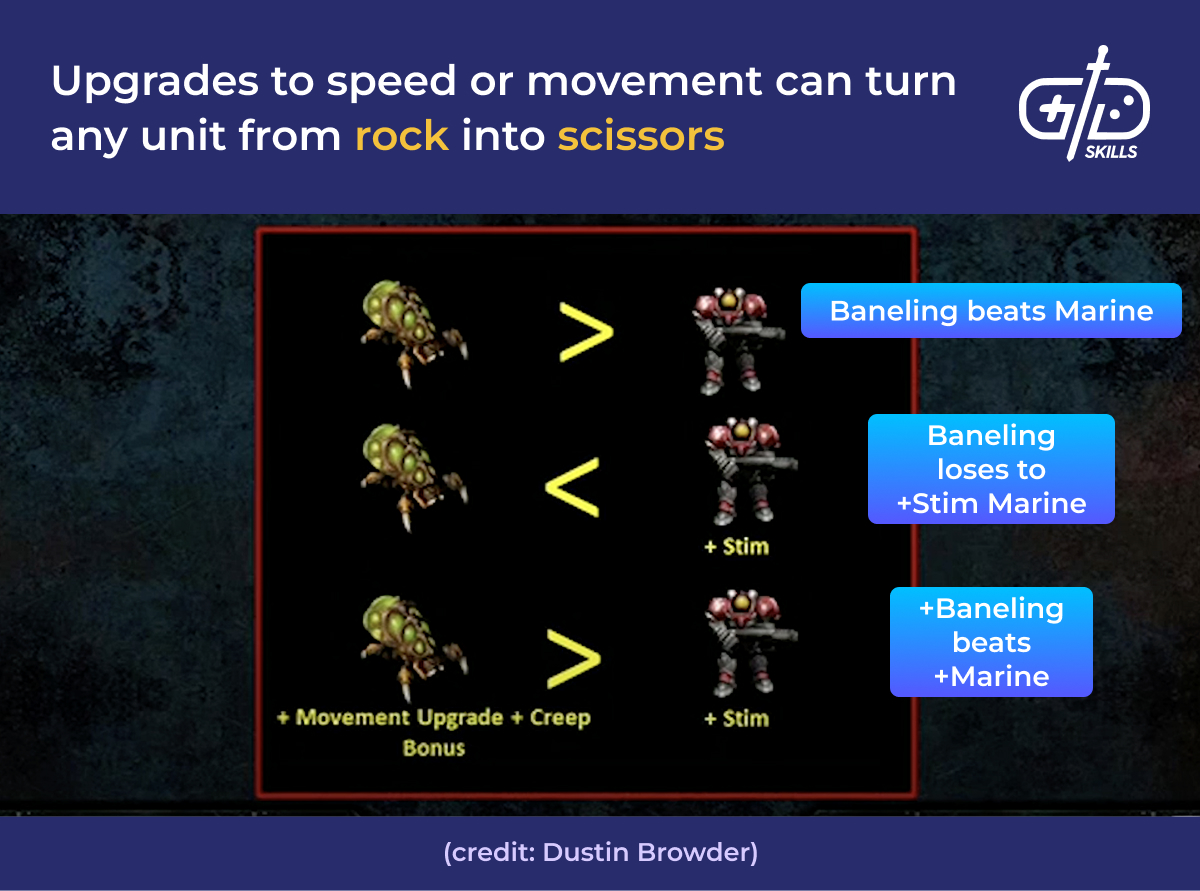
Each unit has a distinct strength and weakness, but, crucially, the advantages come from more than health and damage. RPS in historical RTS games is a suitable example to demonstrate. Archers beat other infantry units since they’re able to aim over the army and attack from a distance. Horsemen are swift and close the distance with ranged units, making them an effective counter against archers. The horses themselves are large, though, and vulnerable to the long reach of a pikeman’s spear. Pikemen, however, are no more effective against ranged units than other infantry.
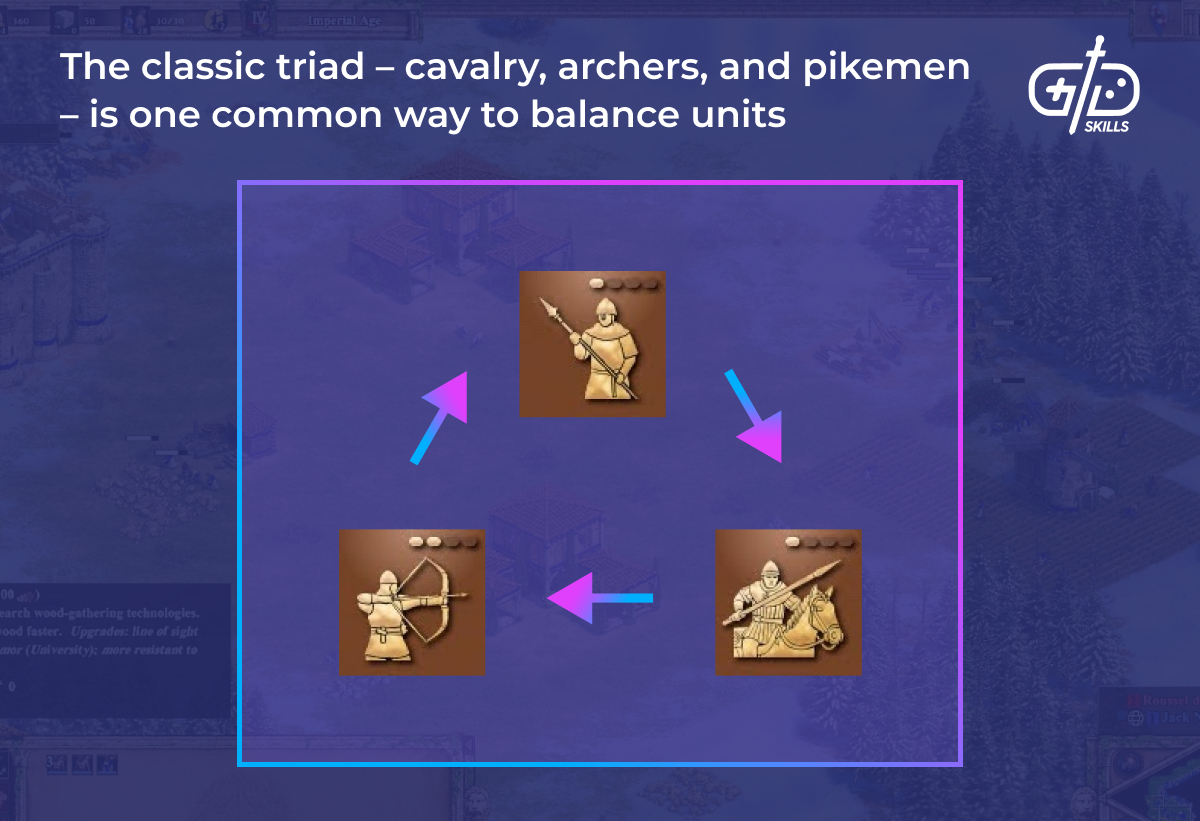
Balancing units, then, means finding other ways to differentiate units than “X beats Y”. The range, speed, and size of the units has a part to play in making one unit effective or ineffective against another. Differentiating by specific characteristics increases the role of skill in deciding matches. A skilled player in an RTS match with more effective micro ought to beat a scissors even if they’re paper, through better control over the units, knowing how to use the terrain, and switching between buffing, healing, moving and attacking.
A combination of movement speeds and movement types go a long way to differentiate units in any RTS game. Maps are much more interesting when the terrain has a part to play in the deployment of units. The need to explore the map to gain information about the enemy also makes having a variety of movement types available necessary for fulfilling the strategy aspect of the experience.
Flying units, to take an example, are able to cross over gaps other players aren’t. The advantage is that the player is able to attack from a position some units aren’t able to reach. They’re equally able to make a quick escape when scouting or harassing the enemy. Cliff jumping units such as the Colossus in StarCraft II, for another example of alternate movement, cross mountainous terrain and over other units with ease. Without the anti-air firepower to counter the Colossus, it’s difficult for ground units to escape.
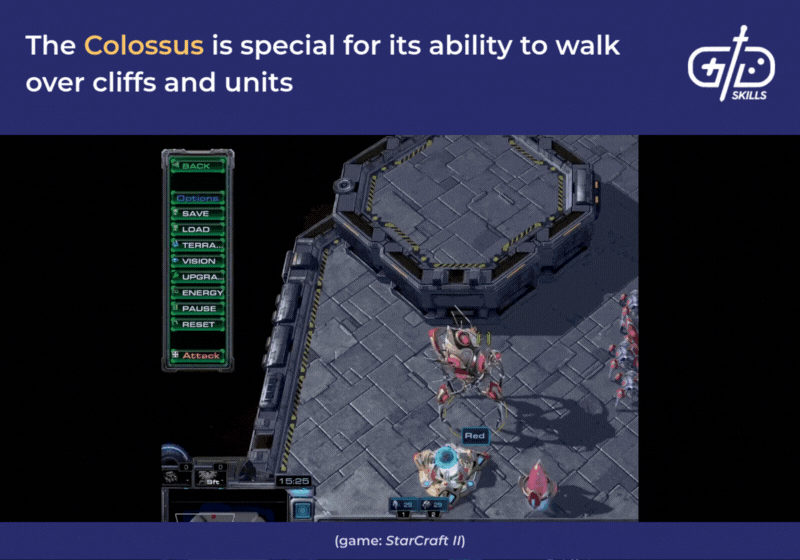
Spellcasters are another type of unit where there’s a lot of room for creativity. Some units cast buffs, boost damage, resistances, speed, and health. Other units use poison, summon lightning, or wreak havoc with their special abilities. A spellcasting unit doesn’t have unlimited mastery over damaging, buffing, and debuffing abilities. Spells also have special effects helpful for information gathering, base construction, and other mechanics specific to the RTS genre. The Witch Doctor in WarCraft III is able to place a ward that grants vision around a certain area, helping players plan their strategy.
Balancing around health and damage is still a valid strategy as long as it isn’t the only means of balancing. One way to distinguish units regarding their health is to divide them into types. Units in StarCraft are categorized into mechanical and biological. Each type takes extra damage from certain attacks, or is affected only by certain abilities. A repair ability works on mechanical units but not biological ones, for example. WarCraft 3 has a list of armor types and damage types with different levels of effectiveness against each other for balancing units.
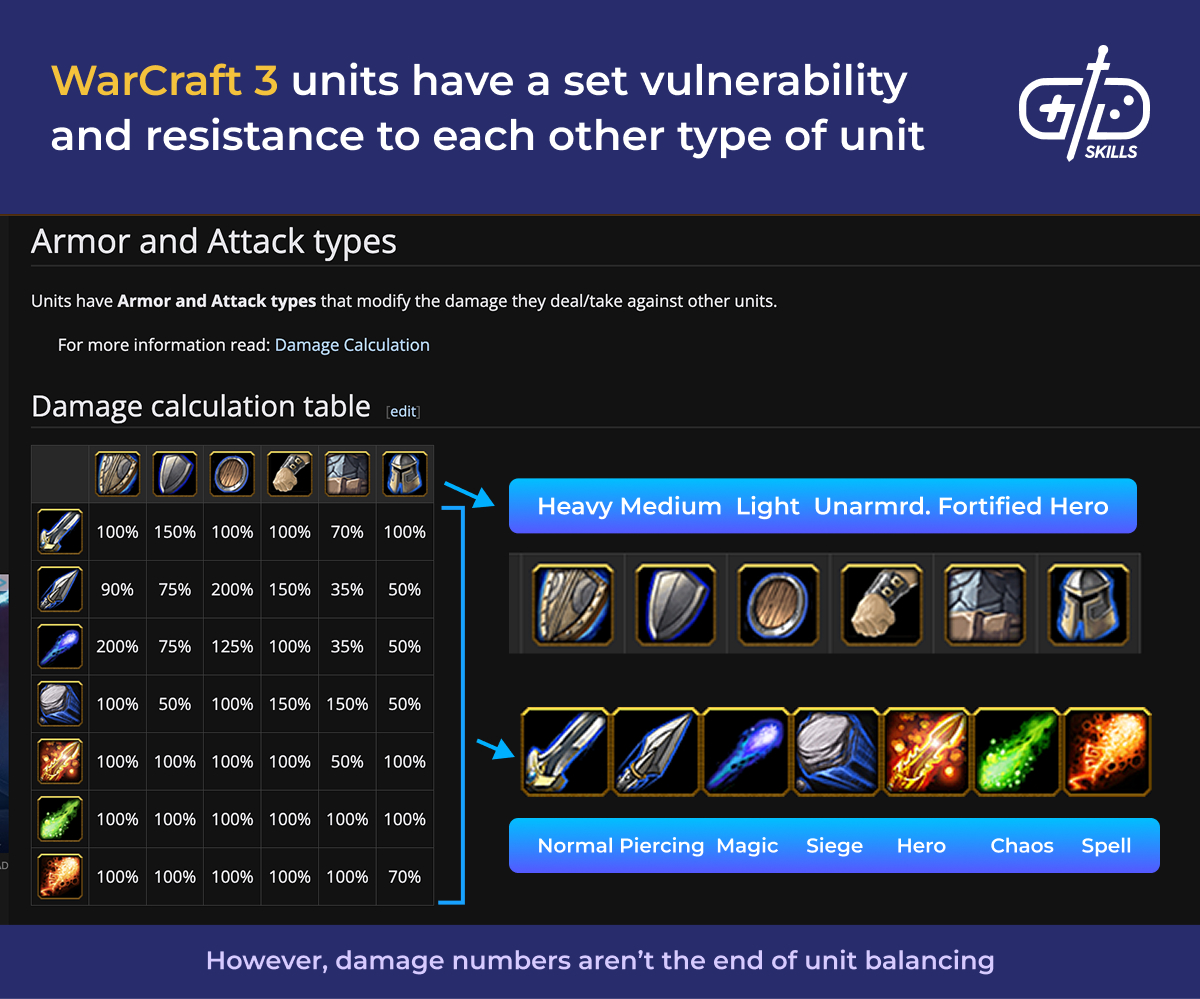
Each characteristic mentioned here works with the others to create the advantages and disadvantages of each unit. An anti-air unit doesn’t just do extra damage against air units, but has other characteristics that make it effective. The anti air missiles in StarCraft are effective against flying units because of range and speed, and less effective against ground units for the same reason. For ground units move in and out of cover, meaning slow-moving missiles are less likely to hit, but flying units are much more exposed.
Balancing the differences between units is a serious challenge for the RTS genre. Determining even the time to kill (TTK) isn’t trivial. TTK is useful for directly comparing whether one unit is better than another, but a few other factors make TTK work differently than, say, a shooter. Every member of a unit that is lost isn’t just lost health, but also lost damage. If one unit does x2 damage than another unit, all else identical, one presumes the former unit is going to kill the other twice as fast, but that’s not true. The double damage unit takes less damage for each defeated enemy and kills their opponent much faster. If both units have 5 members, the double damage unit will only lose a single member before they win the engagement.
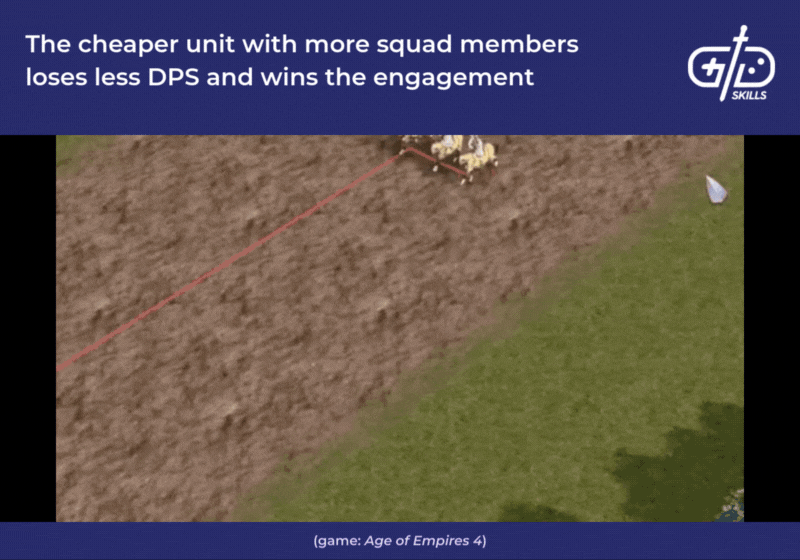
Making sure units have costs equal to their benefits is another key component to ensuring they’re balanced. Choosing how to calculate those costs is beyond the scope of the article, but some calculations are unique to an RTS. A unit’s health, damage, and immediate cost are only one part of calculating its value. A unit is also balanced around its time to create. The time to create further breaks down into several other steps. There is a cost to creating a building for training the unit, which then takes a certain amount of time to construct. There is also a certain amount of time the unit takes to produce in addition to the cost of maintaining and upgrading the unit.
Below is a summary list of the characteristics that distinguish combat units, along with some extra features to consider.
- Movement Speed
- Movement type
- Health
- Resistances
- Range
- Damage
- Damage Type
- Fuel/Energy/ammunition (do the units run out of a resource they need to resupply?)
- Special abilities and spells
- Ability to carry other units
Building an economy is another core element of the RTS alongside combat, which differentiates it from other tactical games. The win condition is tied not to troops but to the economy: losing all the buildings means losing the game. There are often two types of resource. One type of resource directly creates a limit to the amount of units in play. An army requires a significant amount of food to support, for example. Another type of resource indirectly limits units by going towards building the base. Stone, wood, gems, and other building materials are required for defenses and base structures. The methods for building up the economy vary from game to game, and often between factions within a game.
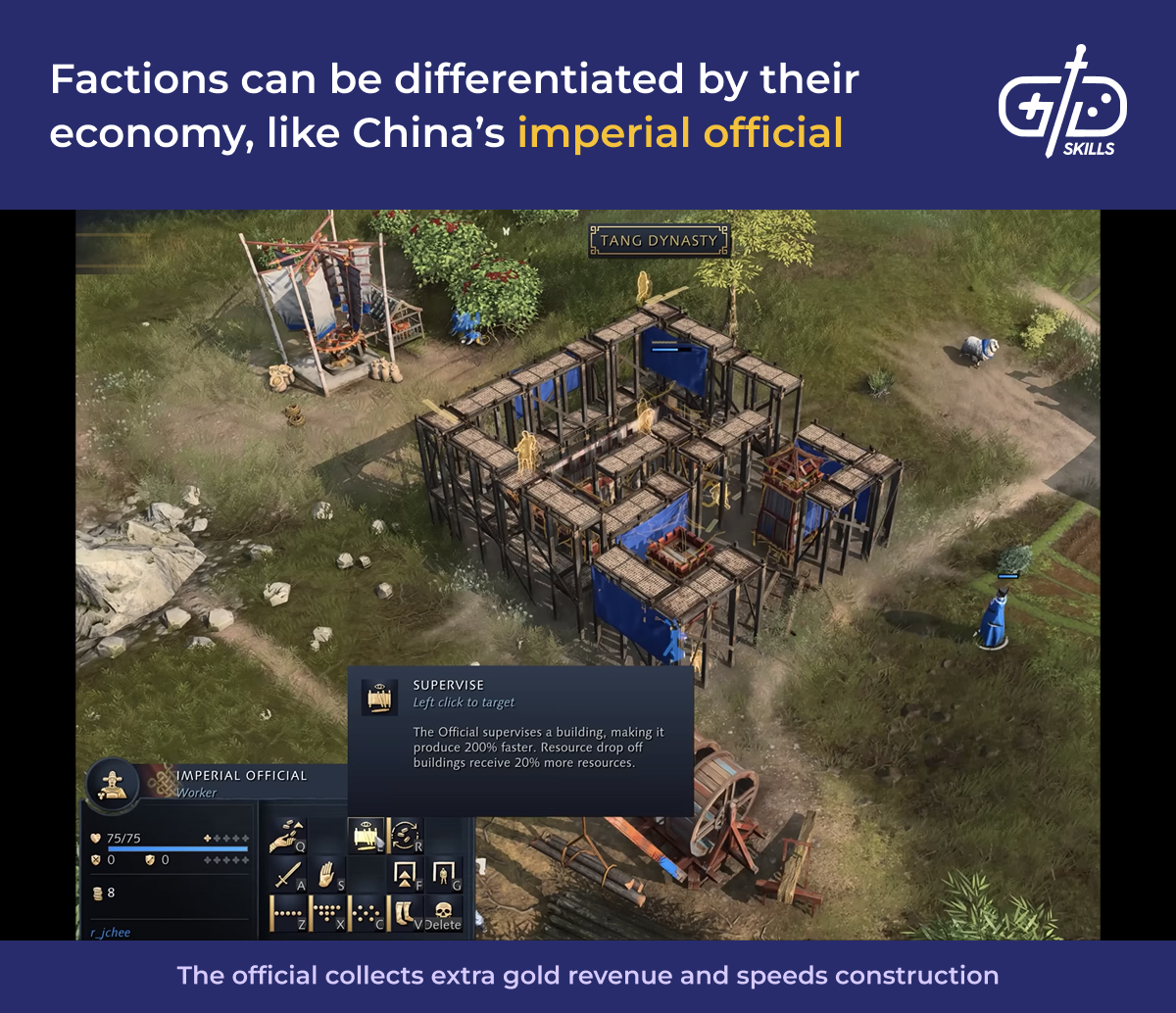
The minimum number of resources is one, but there isn’t one right maximum number. The Command & Conquer series makes do with one resource, Tiberium, for all purposes. Offworld Trading Company revolves around manipulating the market to defeat opponents, so resources are an even more important part of the experience. The game has 13, each with its own price that fluctuates in response to demand.
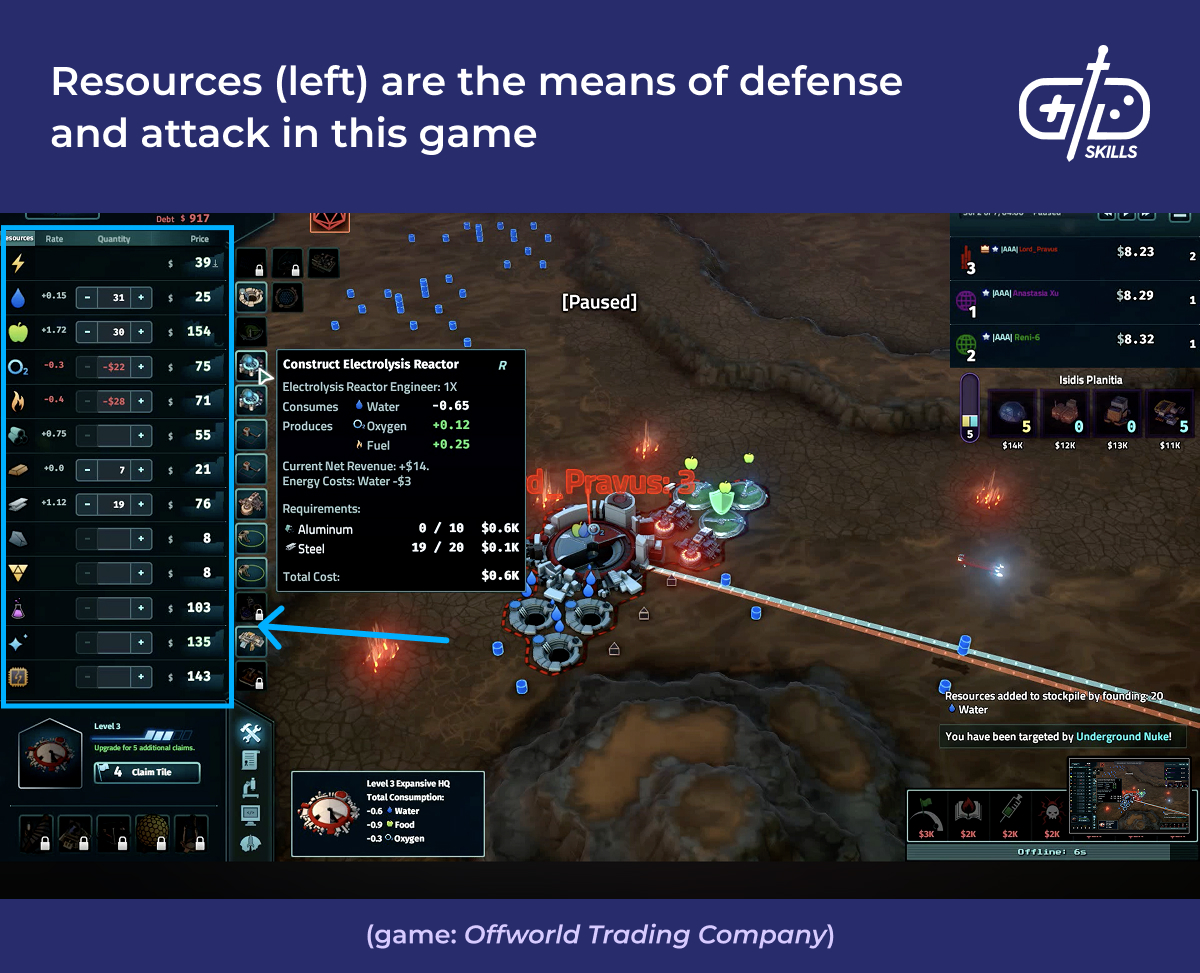
Resources act as speed bumps and keep players from getting too many resources early. Speed bumps are the cost of increasing the economy size and the cost of creating new units. Their goal is to keep players from building up a very large number of units and ending the game before their opponent has the opportunity to build a defense. Resources are one speed bump, but other RTS games have additional strategies for approaching the problem. Gold income in WarCraft III reduces by a percentage the more units are in play. StarCraft II’s designers chose to allow a rush strategy, since the ability to rush at the start makes for dramatic gameplay.
Defense is the other core consideration in an RTS game. Defense adds to the multitasking of an RTS, but it serves a different purpose as the match continues. Defenses early in the game are quite effective. A match ending early isn’t ideal, so being able to stay close to the base and build up the economy is important.
Defenses remaining strong encourages sub-optimal strategies, though. Players turtling in their base and playing SimCity don’t make for engaging opponents. Age of Empires deals with the issue by providing increasingly more powerful siege weaponry as the player progresses through the ages, reserving wall and tower busting gear for the late game.
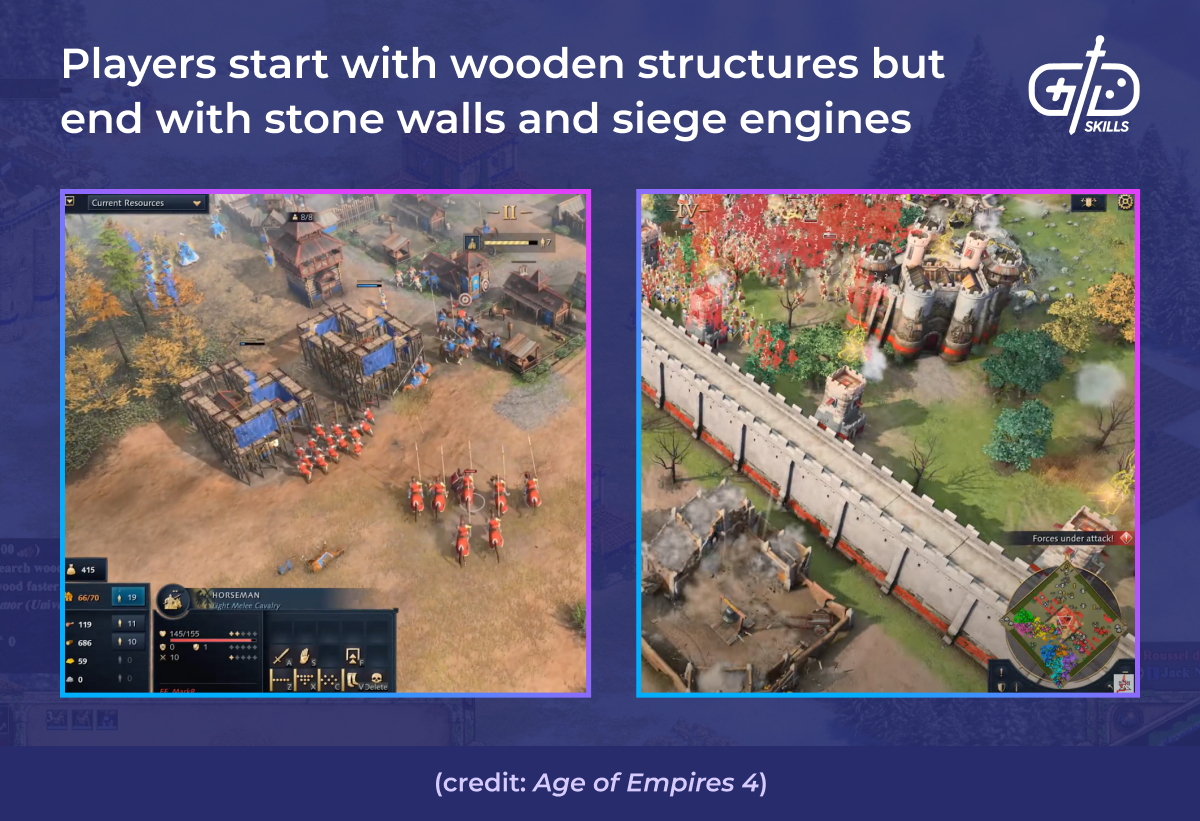
Defense works like combat and the economy: it boils down to placement of troops and investment in structures. Investments made in defense often trade off for a lesser ability to attack. Players make decisions about whether to keep units close to the base to protect their economy and when to take a risk on attacking the enemy. The player also has walls and towers available which are buildable out of the same resources as unit-producing structures, so the player must invest workers and divert resources from combat to create defenses in advance.
Another investment decision in the player’s hands is how to gain information. Skilled play in an RTS is the result of predicting what an enemy is going to do next and creating a counter to that strategy before the enemy enacts it. Knowing whether the enemy is investing heavily in attack units, defense, or their economy changes what style the player chooses in response. Age of Empires 4 has a dedicated scout unit with a large view range for exploring and seeing what enemy bases are up to. Cloaking in StarCraft lets units get closer without detection and explore the map, given the enemy hasn’t invested in detectors.
Where to find a RTS game design template?
Find RTS game design templates online. Assets, presentations, and communities are available for learning the fundamentals and getting started. The dedicated modding communities of many of the biggest RTS games also offer a point of entry into designing for this genre.
Online asset stores and forums contain a number of templates for players to use. Unity has 3D models, animations, and audio resources. There are relatively few templates compared to other genres, but online tutorials and forums help fill the gap. The Game Development Stack Exchange has answers to questions about fundamental coding and mechanics, but also about design, such as unit balance and resource management systems.
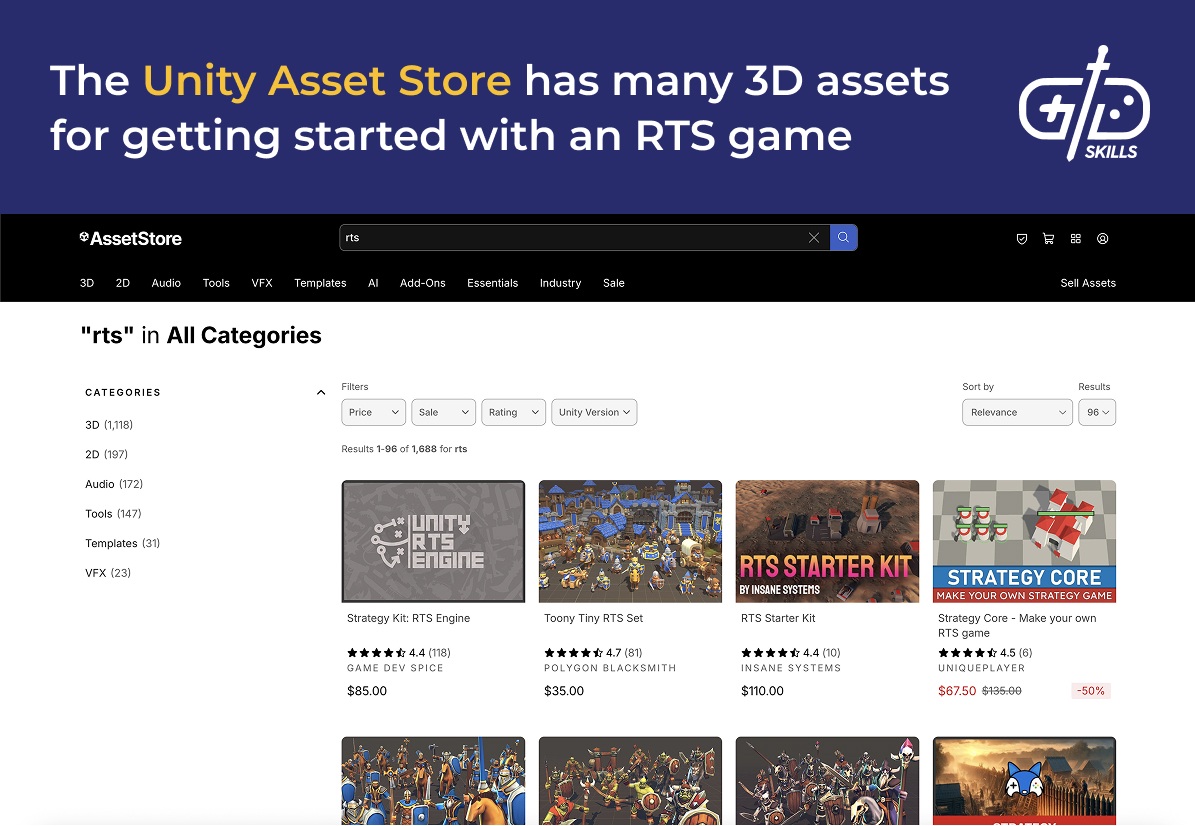
Game designers have publicly discussed their work online as well. GDC presentations are publicly available, in particular about the design principles of StarCraft 2, its game’s pathing system, and Offworld Trading Company’s innovations. Look to online communities for a direct line to other devs. Our Funsmith Club discord server is an active and responsive community where advice, portfolio reviews, and challenges are available for getting work in front of other creators.
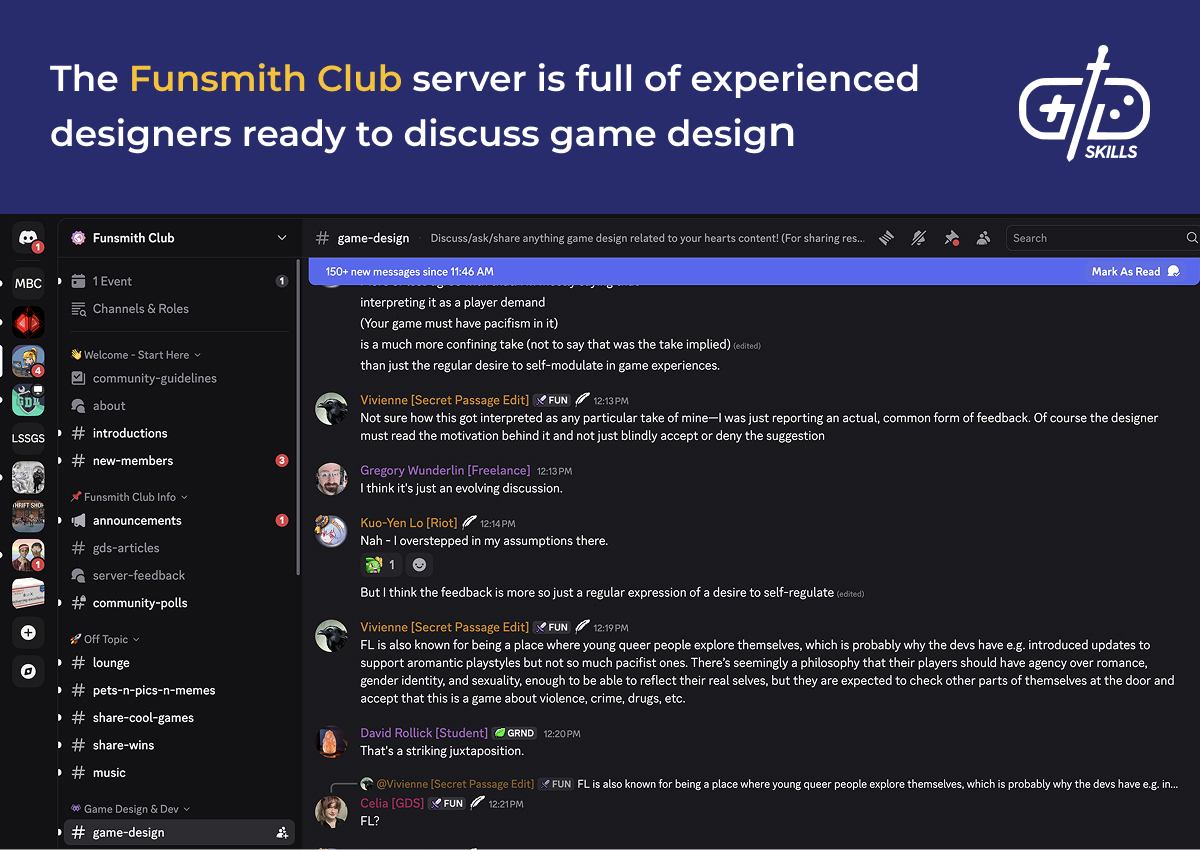
Starting with mods is a way to get into RTS design without starting from scratch. Longevity is a concern of most RTS developers, so the biggest games often have official modding tools for creating custom maps and matches. Age of Empires 4 is one of the most recent with its Content Editor, although some prefer Age of Empires 2’s solution. WarCraft 3’s World Editor is older but has been the source of influential mods including the original DotA.
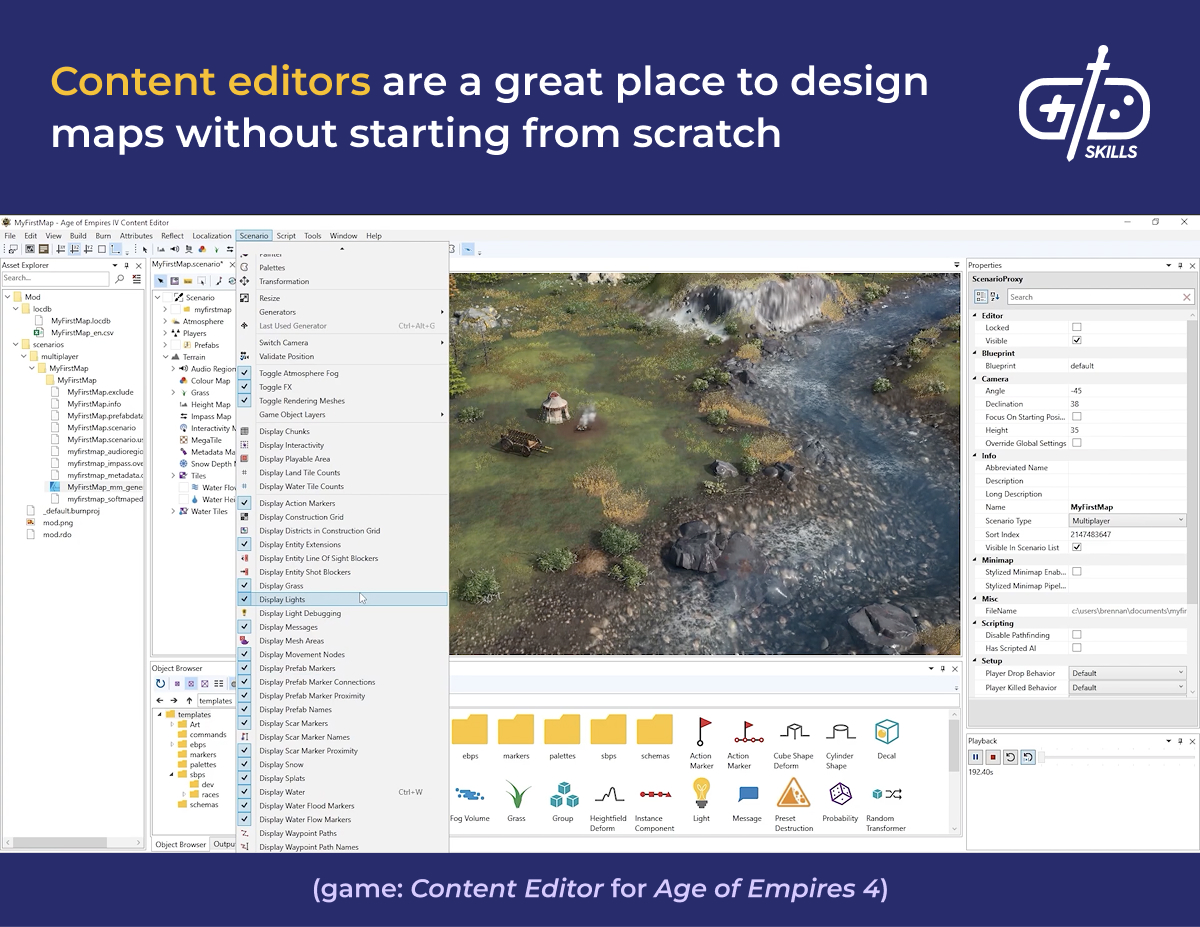
What is an example of a RTS game design document?
No examples of an RTS game design document have been published. Use our general GDD instead to get started with documentation. A game with lots of complex balancing tweaks needs detailed descriptions of its features and records of who owns each task.
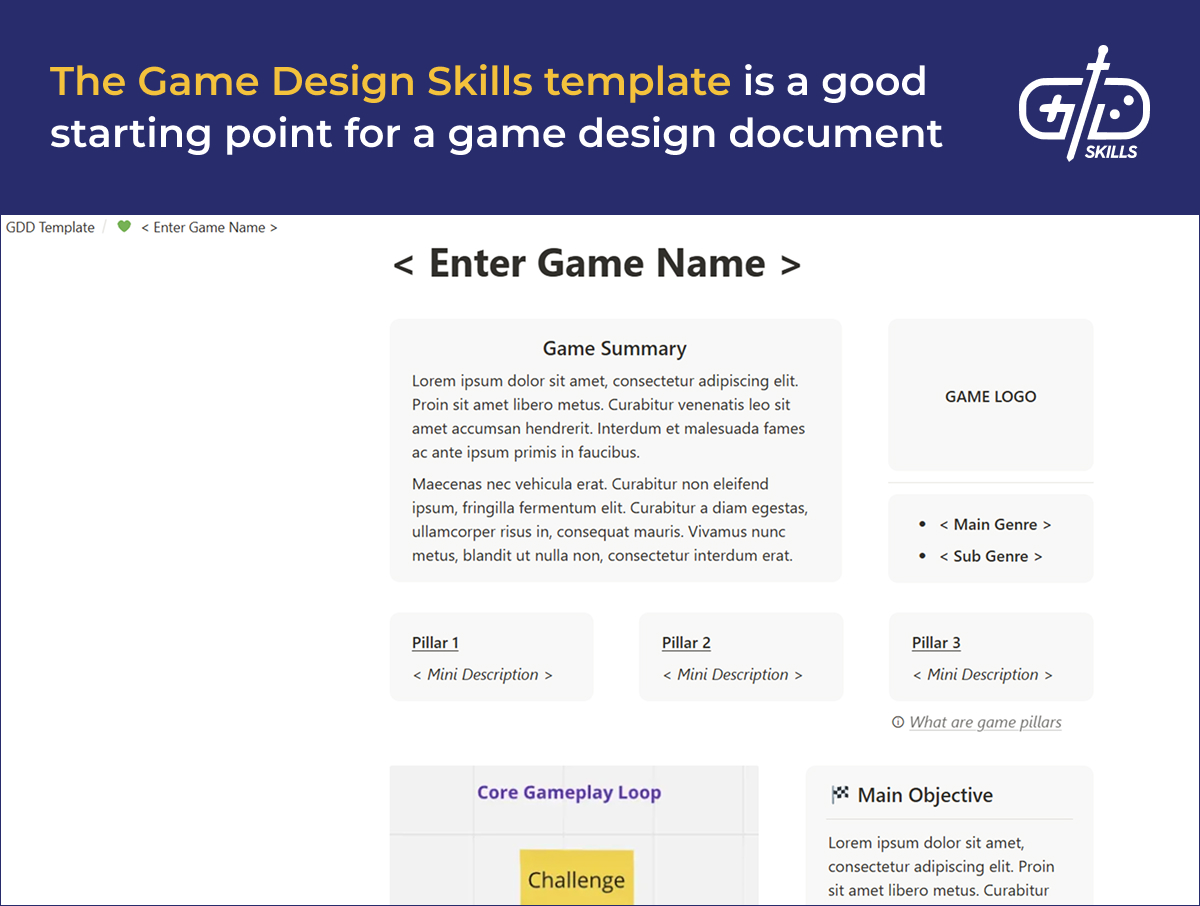
The general GDD template has models of a main GDD and feature documents. The main GDD starts with basic information for getting on the same track about the game’s direction: a summary, the objective, the core gameplay loop, and the game’s core pillars. Our AAA-style template has more room for market research and competitors in the planning process.
Feature documents are sub-documents which expand on features in more detail than is possible in the main document. The goal of a GDD is to condense the information, not overwhelm the team with it. Each feature document describes the feature, how it interacts with other features, and the requirements from each discipline on the team.
Pathfinding, for example, requires several disciplines. The artists create animations, the UI folks create a marker to show the unit’s goal, and the programmers create a pathfinding algorithm. The pathfinding must also move around the placement of buildings and defenses, so it’s important to mark down base building and other mechanics the pathfinding is going to interact with.
There’s so much more to say about RTS games, so please tell us what you think in the comments. Are there other topics you’d like to see discussed? Do you have advice from your own experience designing RTS games? Please let us know in the comments!


